A photo essay about an adventure to the 2017 Royal Highlander Festival in Bhutan, a celebration of nomadic culture in Bhutan’s highest settlement.
It’s not every day you get to chat with the King of Bhutan, dive out of the way of yaks in outfits, and sip hot tea among a sea of traditional headdresses, all at a festival situated at more than 4,000 meters above sea level.
Just sayin’.
Surreal as it sounds, that’s exactly what went down when we visited the second Royal Highlander Festival in Bhutan.
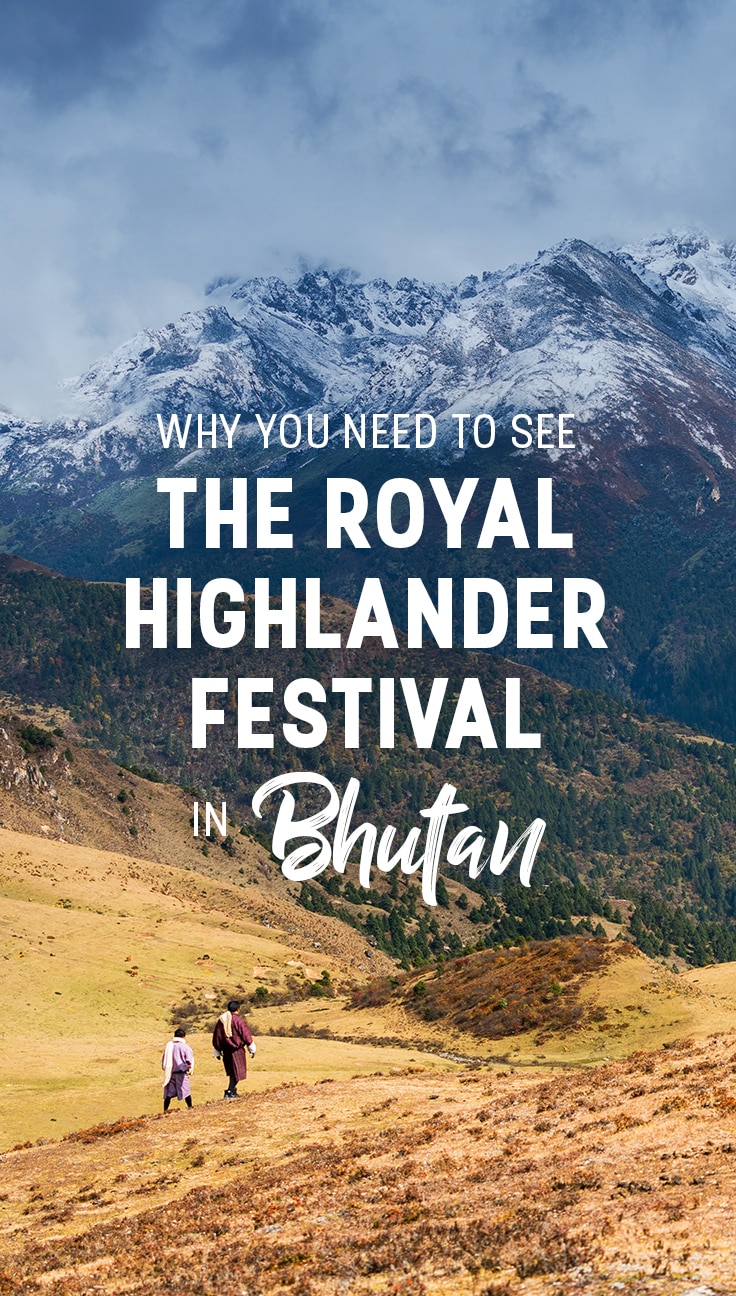
What is the Royal Highlander Festival?
For those not in the know—which is most of the world at this point in time—the two-day Royal Highlander Festival is an annual celebration of nomadic highlander traditions in Laya, Bhutan.
The festival began as the brainchild of the fifth king of Bhutan, Jigme Khesar Namgyel Wangchuck. Before the advent of the Royal Highlander Festival, the mountainous northern areas of Bhutan lacked representation on the country’s festival calendar; most Bhutanese festivals occur in more “accessible” regions of the country.
To resolve this issue, His Majesty initiated the Royal Highlander Festival to bring some light and love to the hardy highlander people thriving in the Himalayas of northern Bhutan.
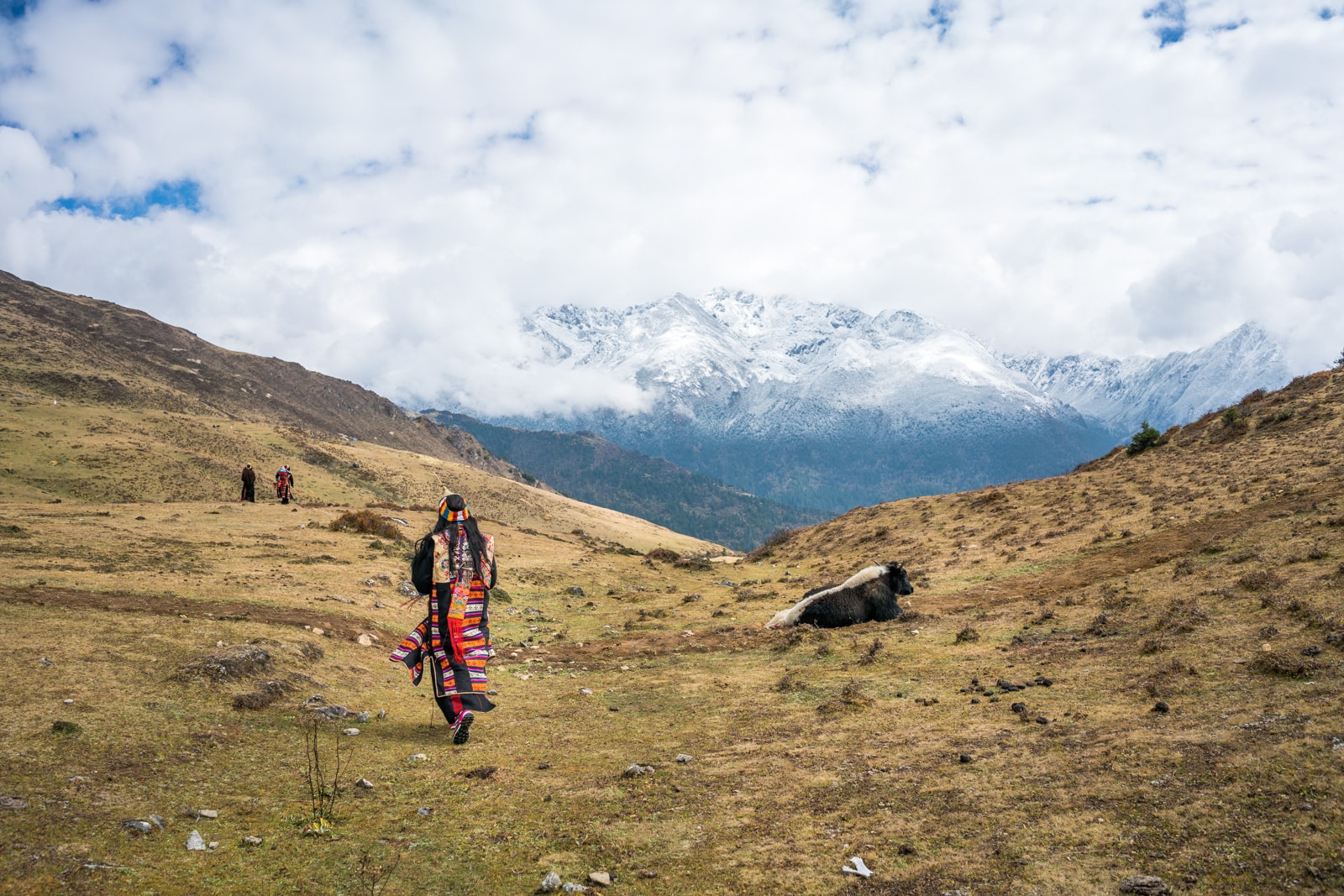
Welcome to the highlands of Bhutan!
Despite 2017 being only the second year of the Royal Highlander Festival’s existence, it drew quite the crowd. From local Layaps in pointed beaded headdresses, to groups of Monpas in dreaded yak hair hats, highlanders of all ethnicities congregated in Laya to share their culture with the rest of Bhutan. Royalty, volunteers, and visitors from all over Bhutan completed the crowd, coming together to ensure the festival’s success. There were some foreigners present—our tour group included—but we were by far the minority. No tourist traps at this festival!
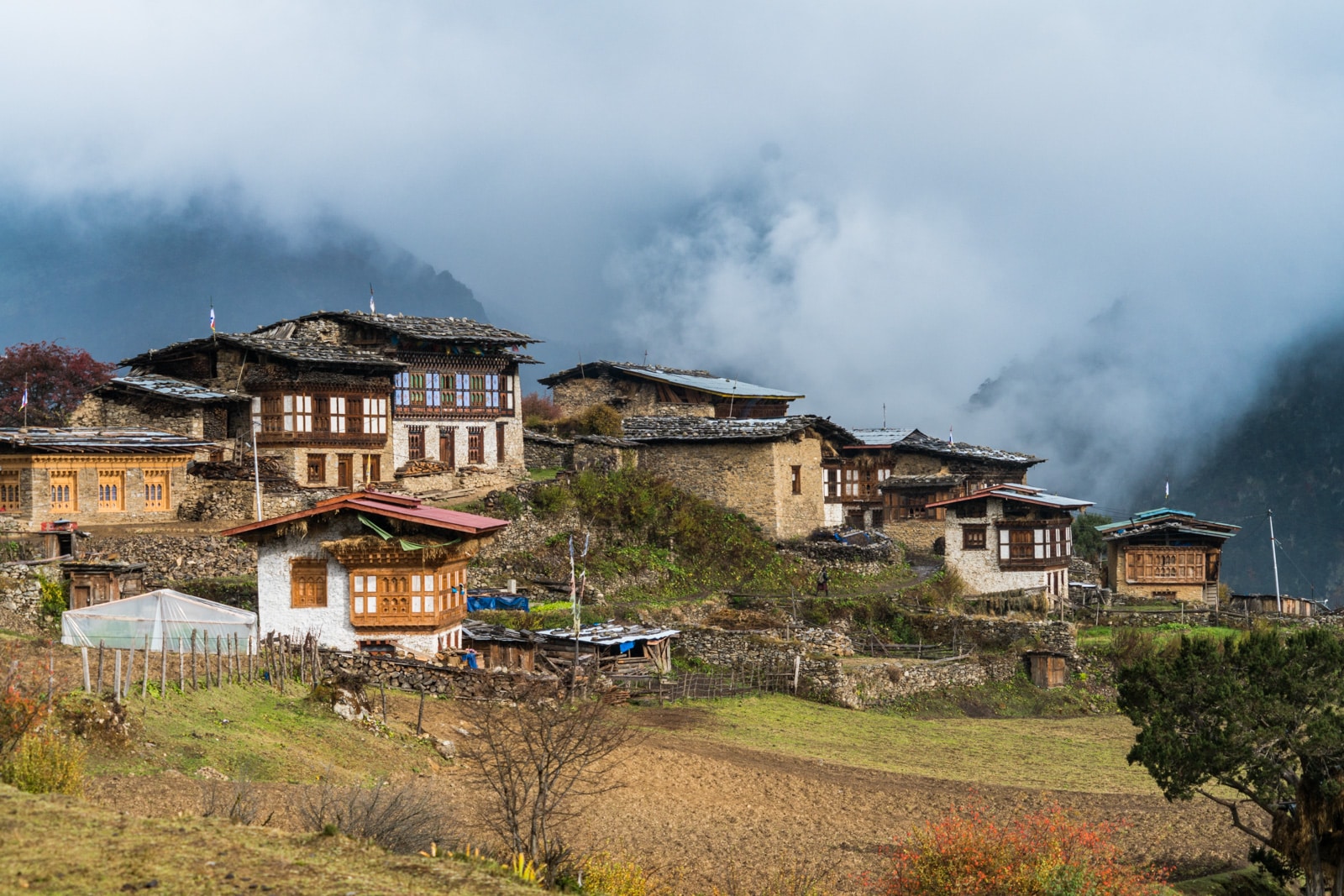
Laya in the clouds
The road (or lack thereof) to Laya
The fact that any outsiders showed up at all is impressive in itself, as traveling to Laya, even for a native, is a multi-day endeavor.
Laya is one of the most remote settlements in Bhutan, and the highest in the country at more than 3,800 meters (12,500 feet) above sea level. There’s no road to Laya, so the only ways to reach the festival are to trek or to hire a private helicopter. Bhutan’s few helicopters were rather preoccupied serving some of the dignitaries attending the festival—but most people, including the King of Bhutan, opted to trek to the festival—so trek we did!
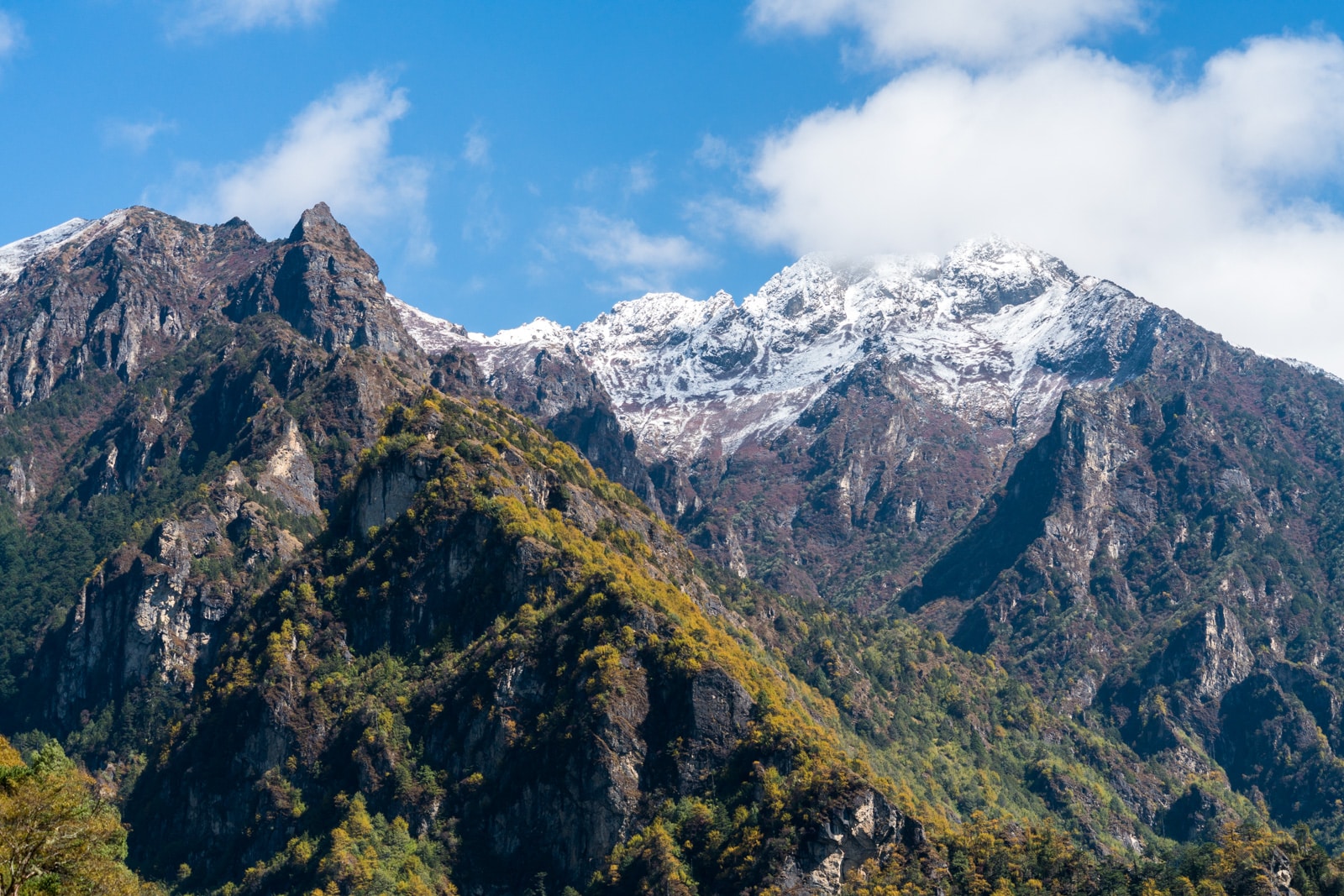
A solid starting view to our two-day Gasa – Laya trek.
Over the span of two days, our tour group and guides trekked from the village of Gasa to the village of Laya. Though we were plagued by some unlucky injuries and seemingly incessant cold and rain, the scenery more than made up for any struggle.
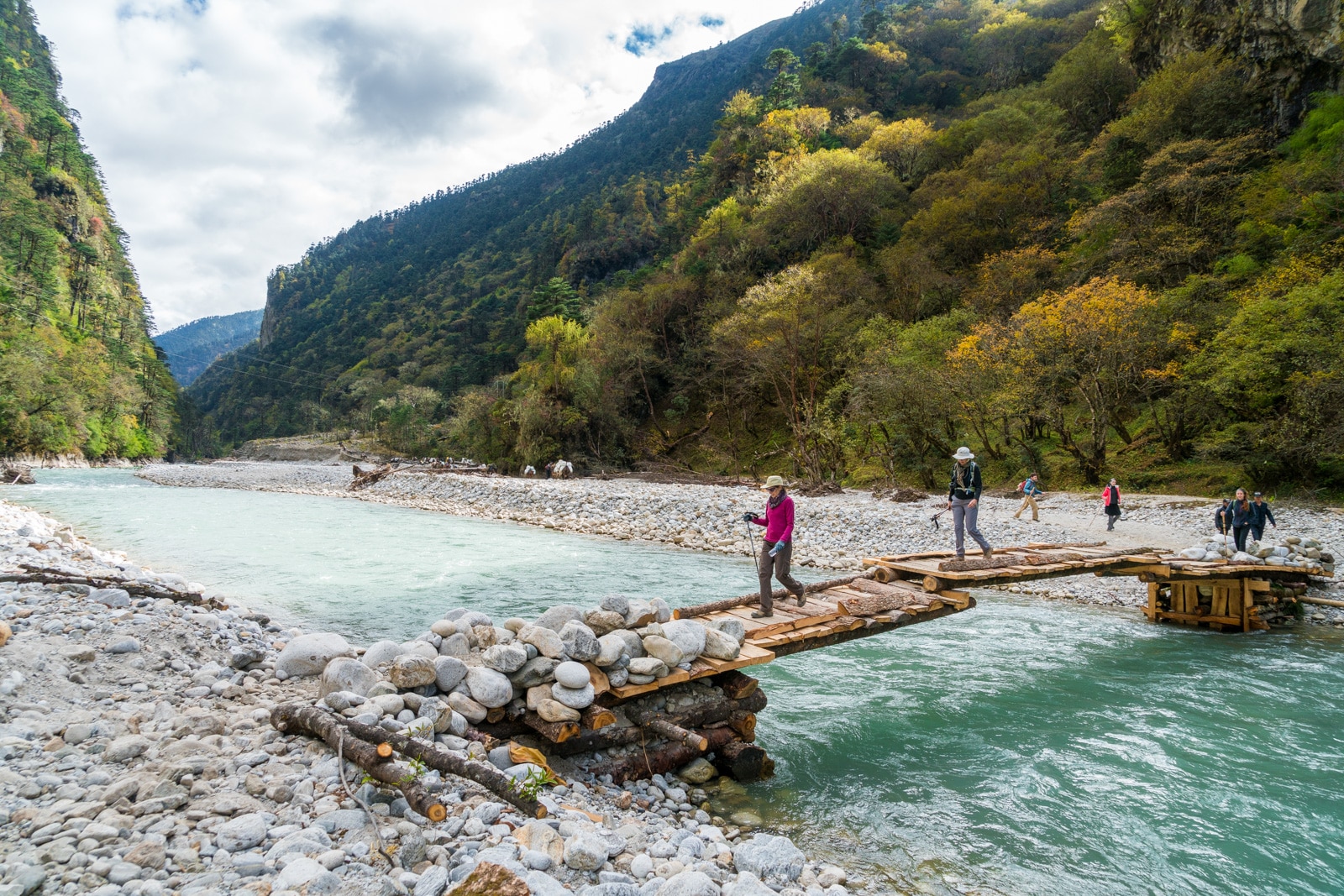
This picture perfect river valley also doubled as our campsite on the way back.
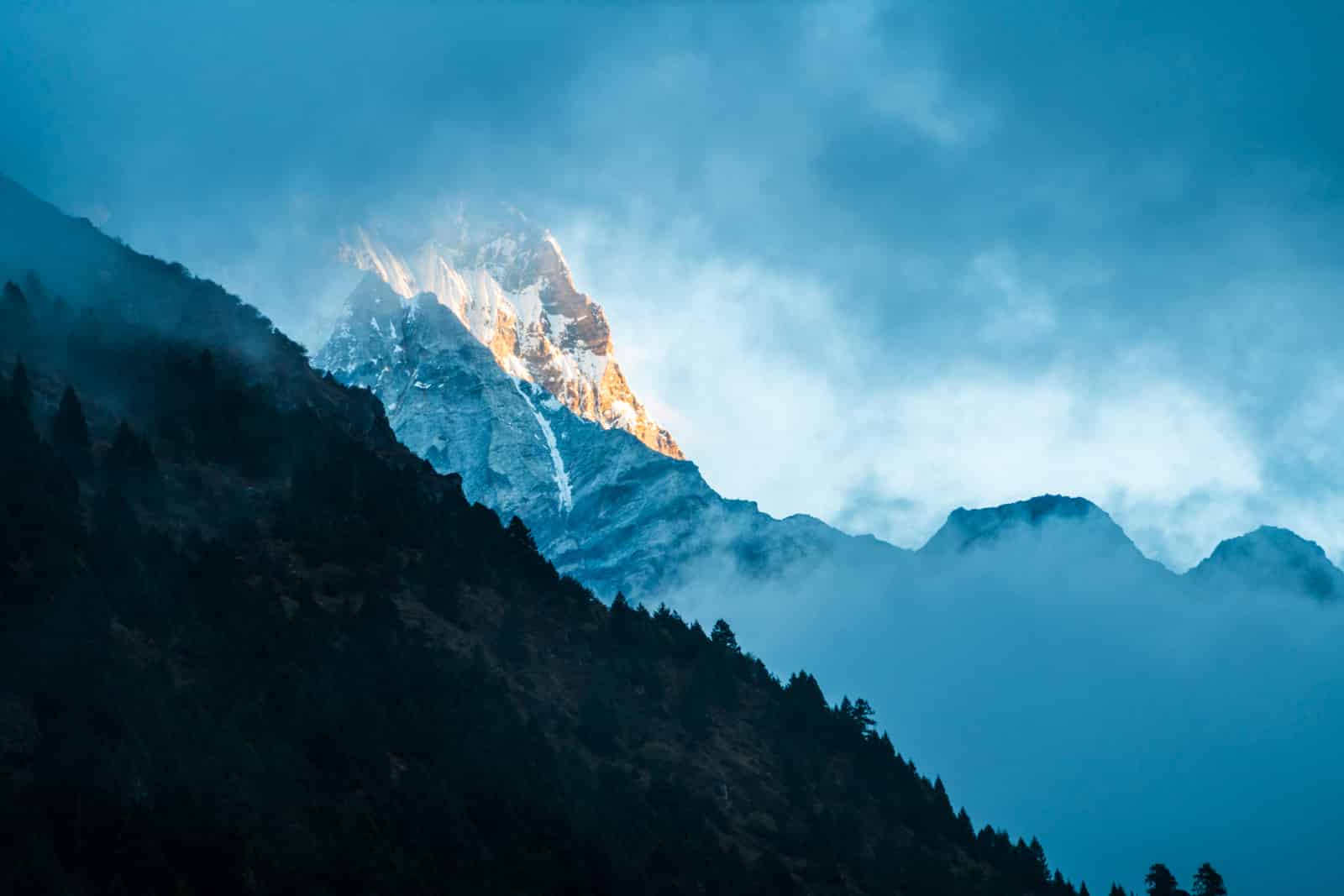
I emerged from my tent on the second morning to a glimpse of mountains through the rain clouds. Not bad for first view of the morning, eh?
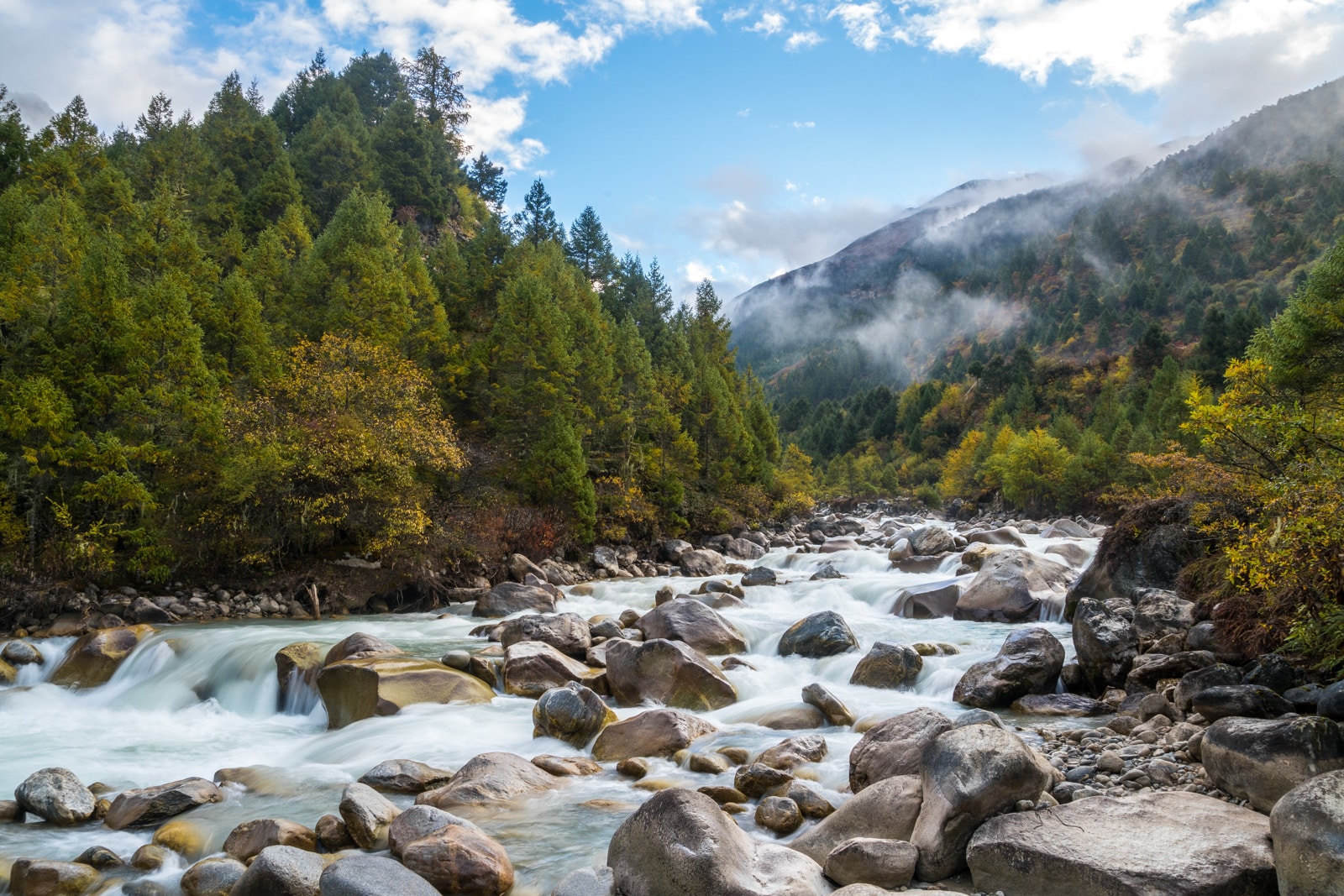
The river running past our midway campsite.
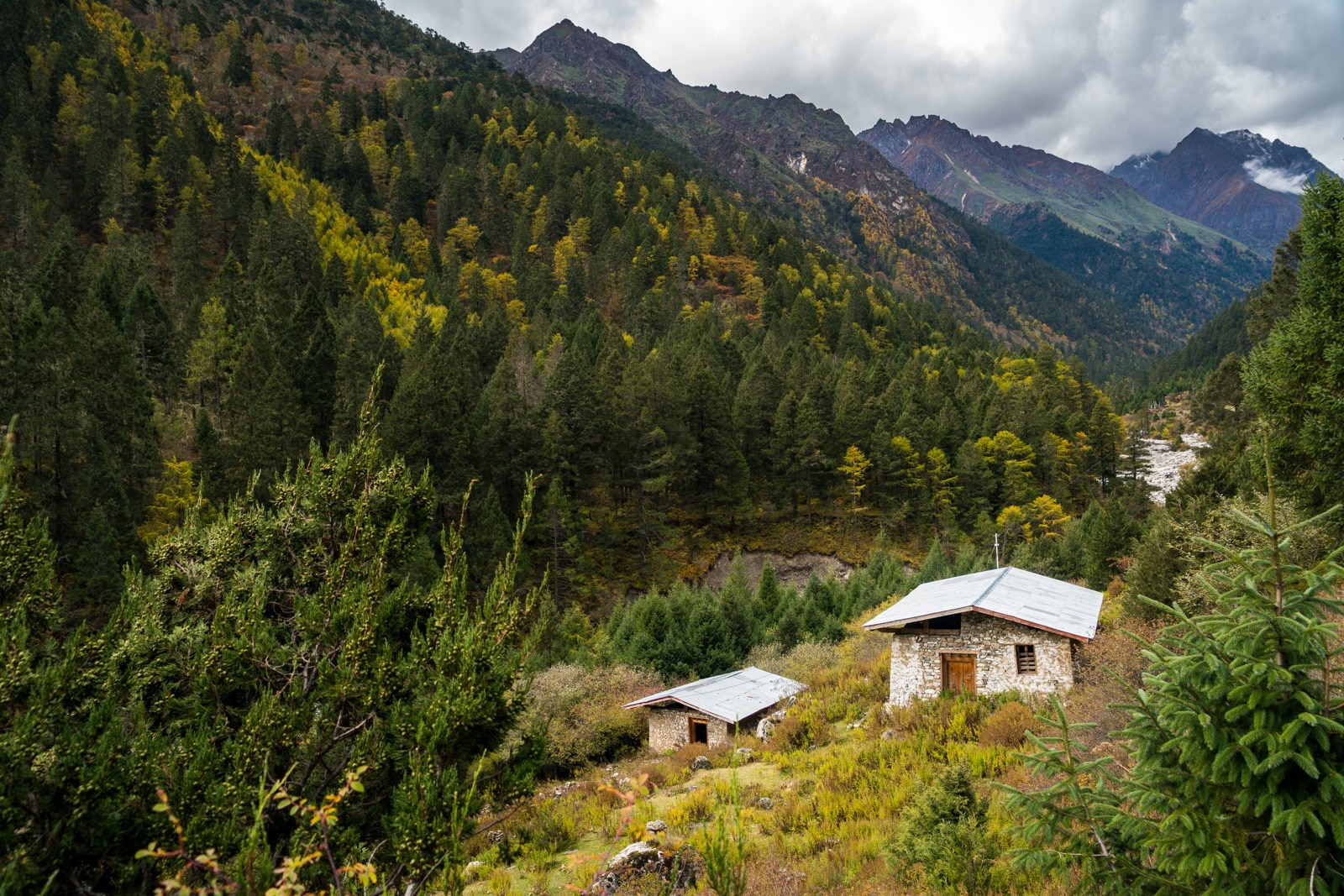
Scenery along the second day’s climb to Laya.
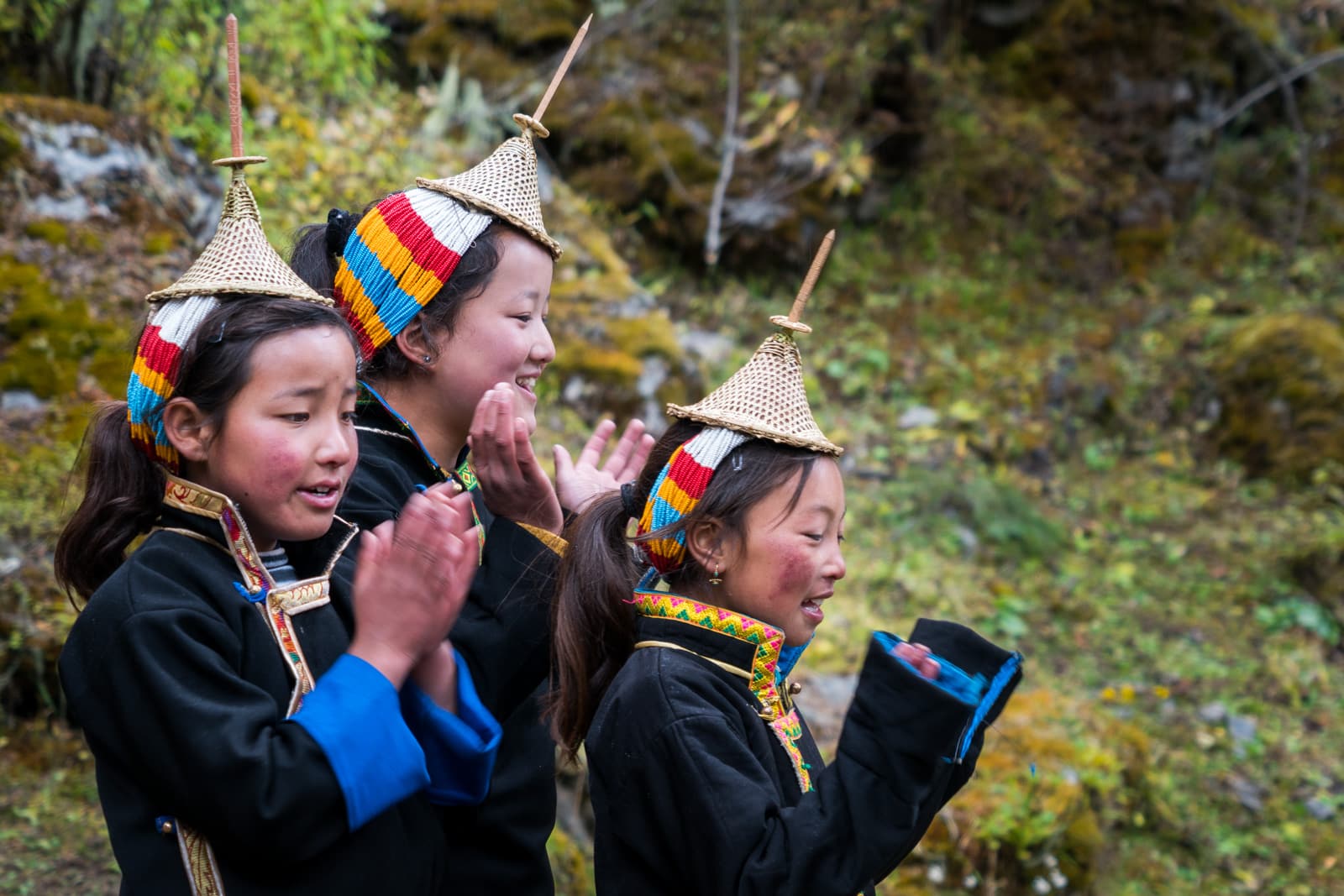
Nothing like a cheery face to motivate you on the home stretch! These local Layap girls cheered on runners racing up to Laya during the Snowman Run, a 26-kilometer (16 mile) race from Gasa to the Royal Highlander Festival grounds in Laya. (Yes, there are people in this world fit enough to run long distance races at 4,000 m above sea level.)
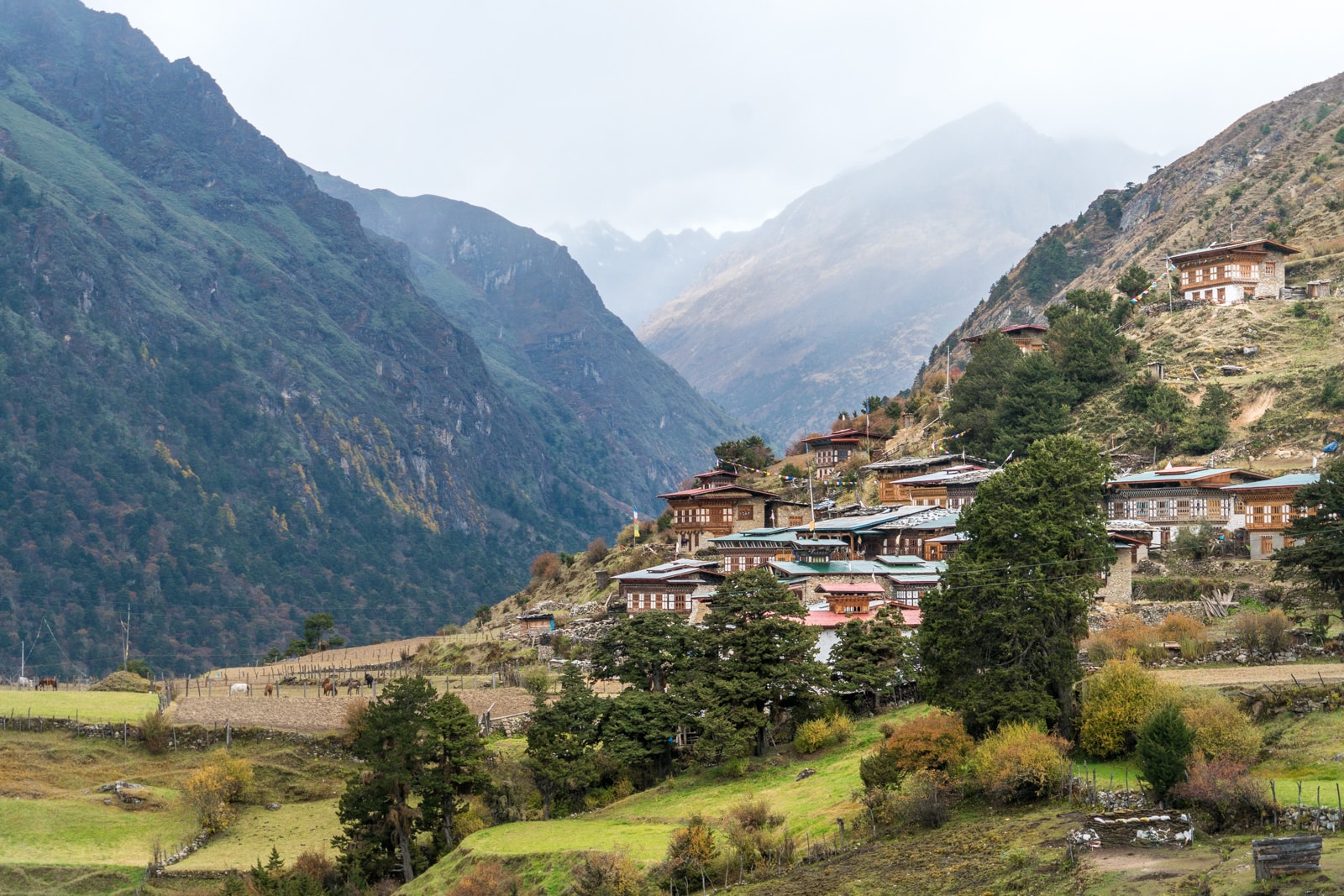
Hiya Laya!
The 2017 Royal Highlander Festival in photos
And so began the second Royal Highlander Festival in Laya.
Over the course of two days, men wrestled, horses raced, and children danced. Tireless runners scaled mountains while clueless cows won prizes.
Though Bhutanese custom dictates we couldn’t take photos, we had a chat with the King of Bhutan (who totally looked like Tom Cruise from Top Gun in his aviators). He spotted us while strolling through the festival to greet and speak with local people, and warmly welcomed us to Bhutan and asked how our trip was going so far. We also had tea with the humble yet elegant Princess Namzey, who was volunteering at the festival in a bright orange jumpsuit.
In between casually hanging out with royalty, we ogled vibrant textiles and jewelry adorning the local visitors, watched adorable animals on parade, and devoured hot yak sausages to keep up our energy. (Protip: Do eat. Tastes like hot dogs.)
The Royal Highlander Festival in Bhutan was a visual treat—and a photographer’s dream—so rather than tell you how it was, I’ll let the photos do the talking.
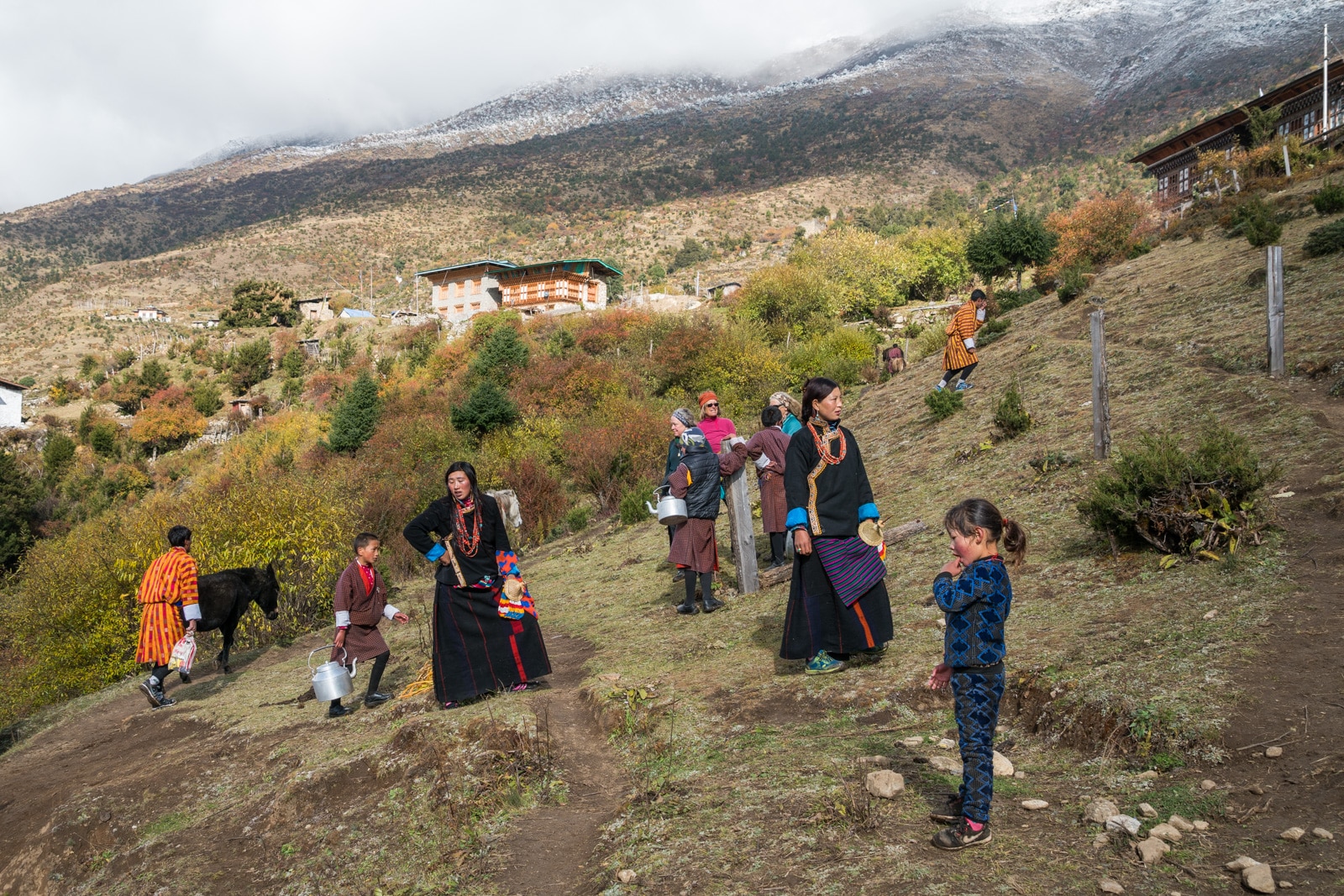
The walk up from Laya to the 4,000-meter (13,100 feet) plus fairgrounds was colorful and festive. Plenty of curious people stopped to chat and ask us where we were from, and one man even showed us a massive sword!
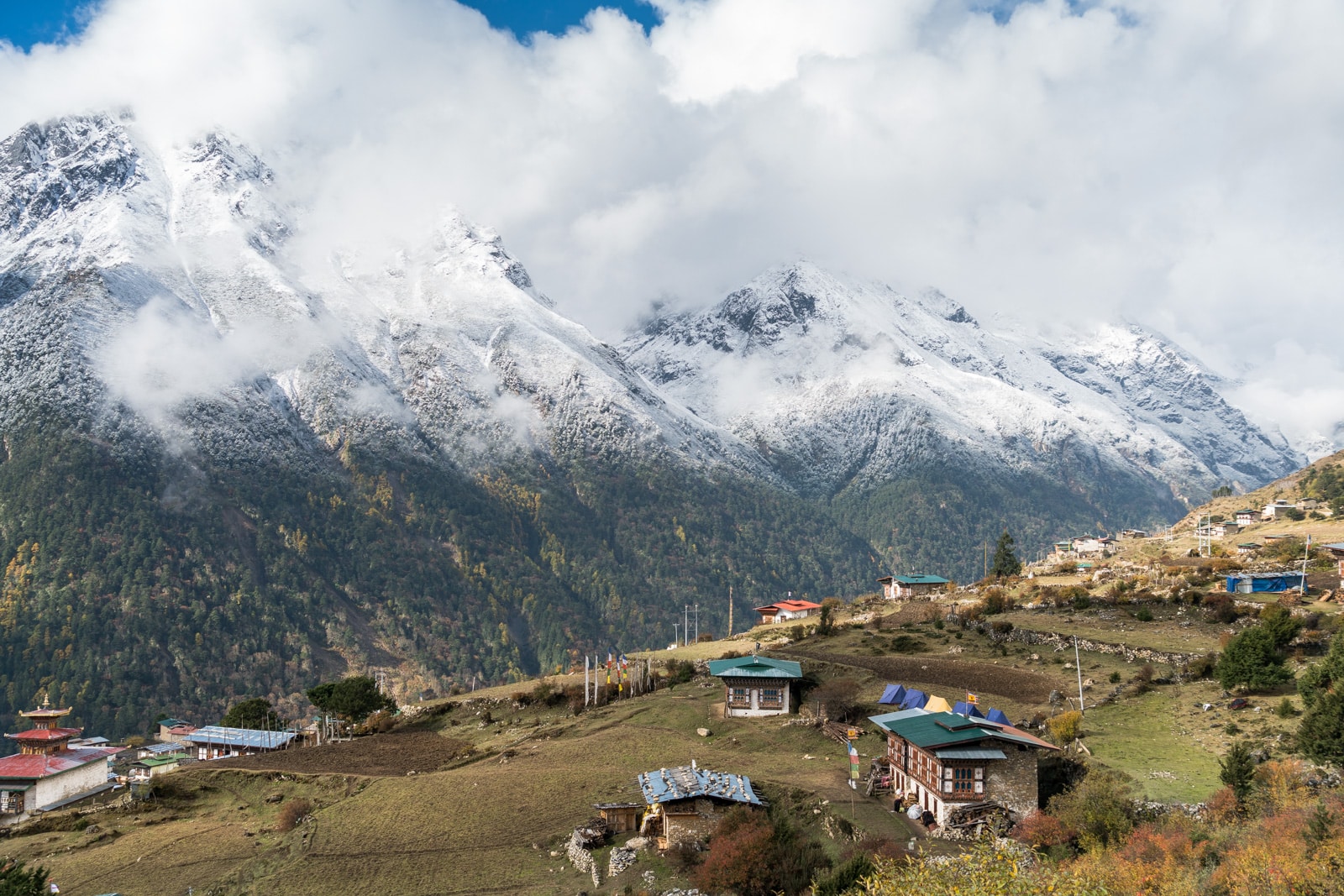
But the walk was also tiring, even for locals! Luckily, there were plenty of stunning views to treat your eyes while catching your breath.
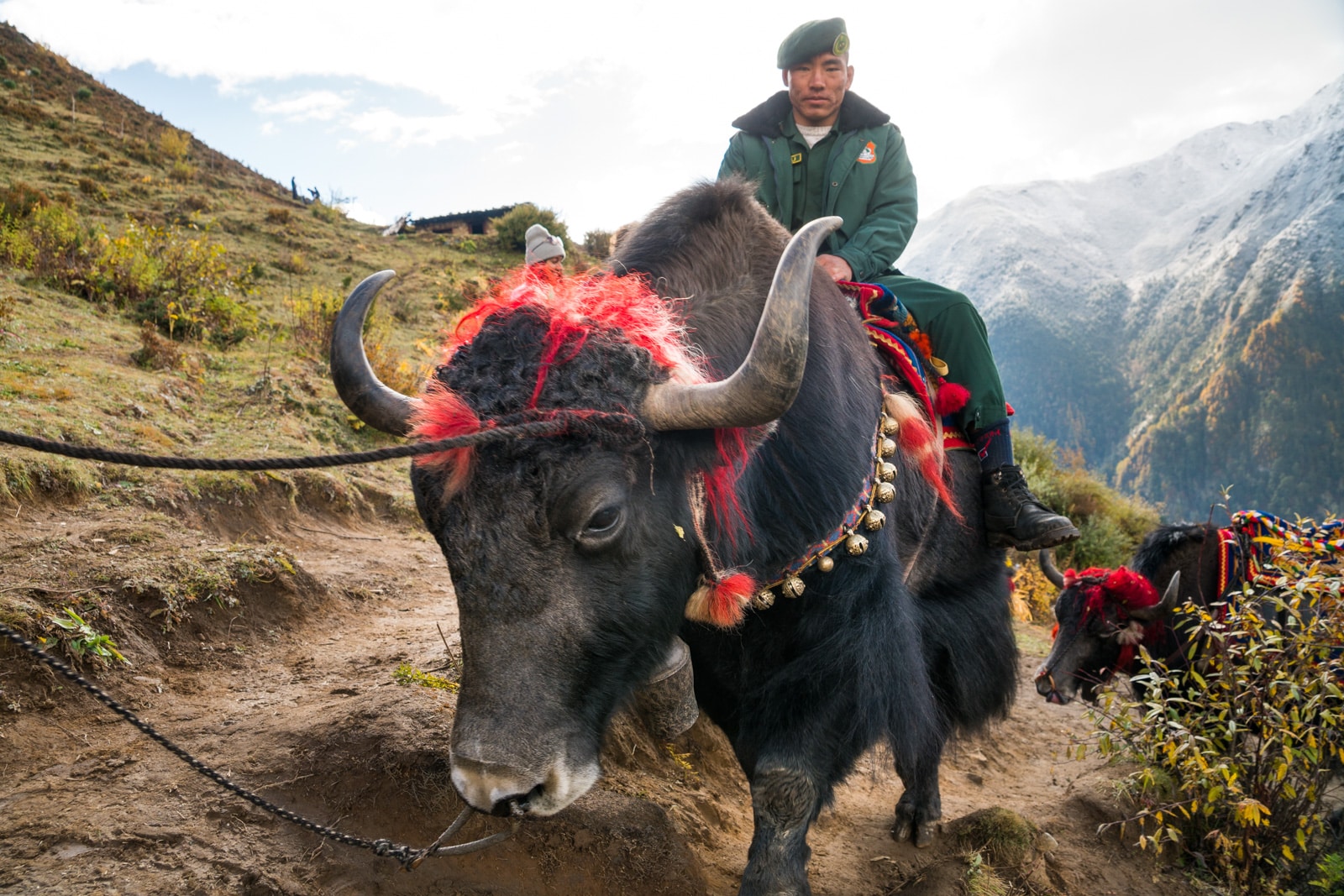
… and plenty of animals on the move to keep you on your toes!
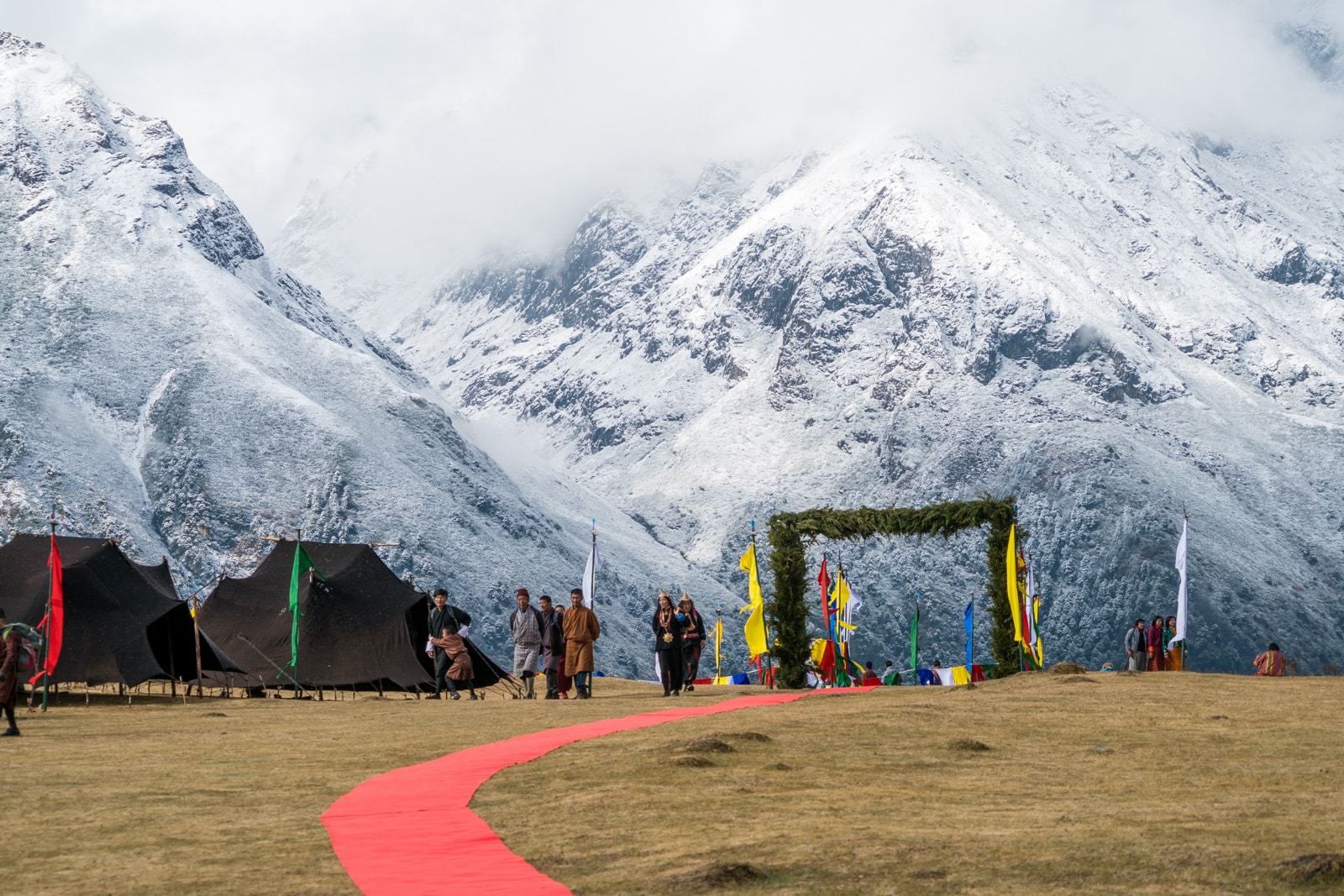
After the 45-minute climb at such high altitudes, the entrance to the festival grounds looked—and felt—like the gateway to heaven.
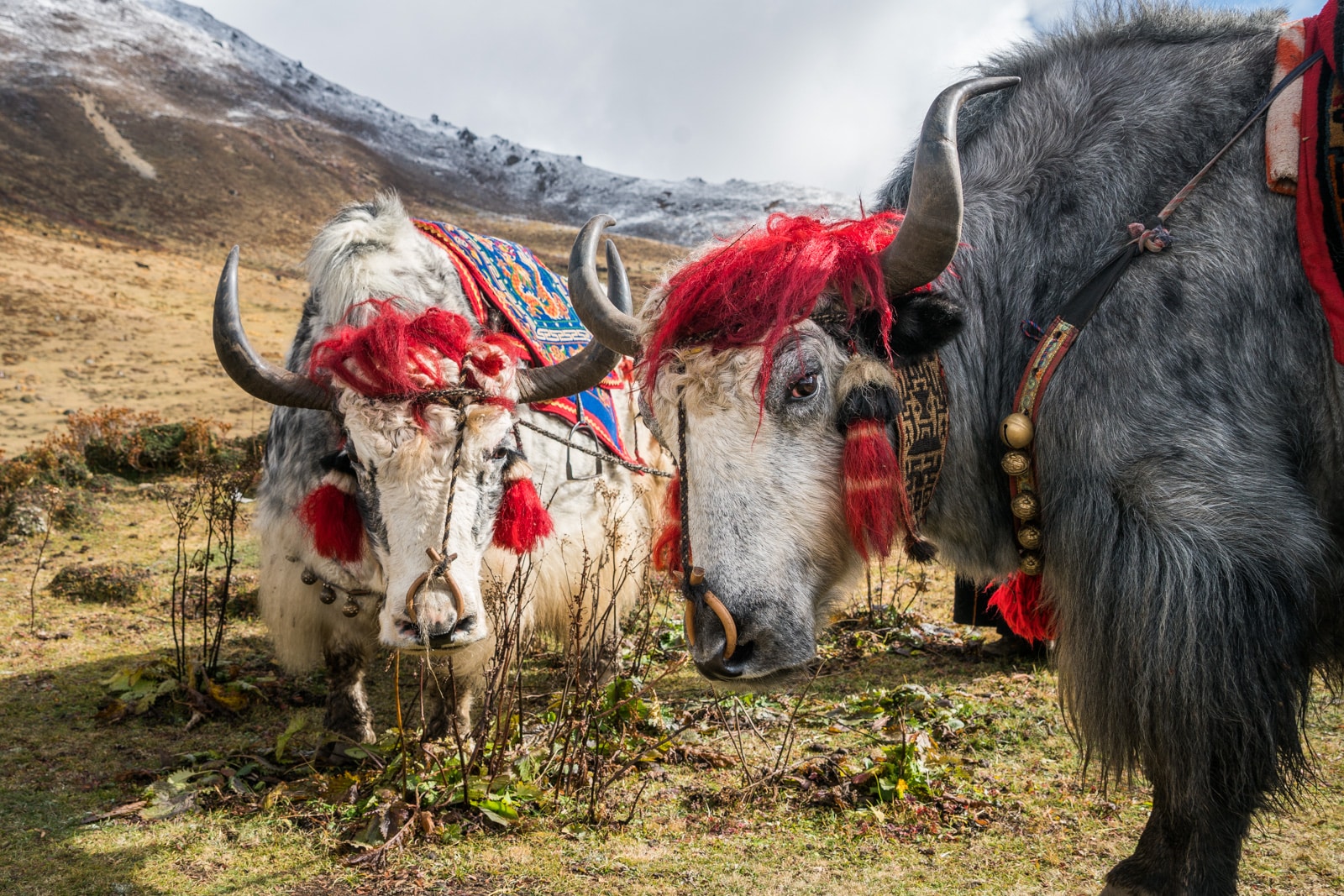
Complete with divine creatures and all.
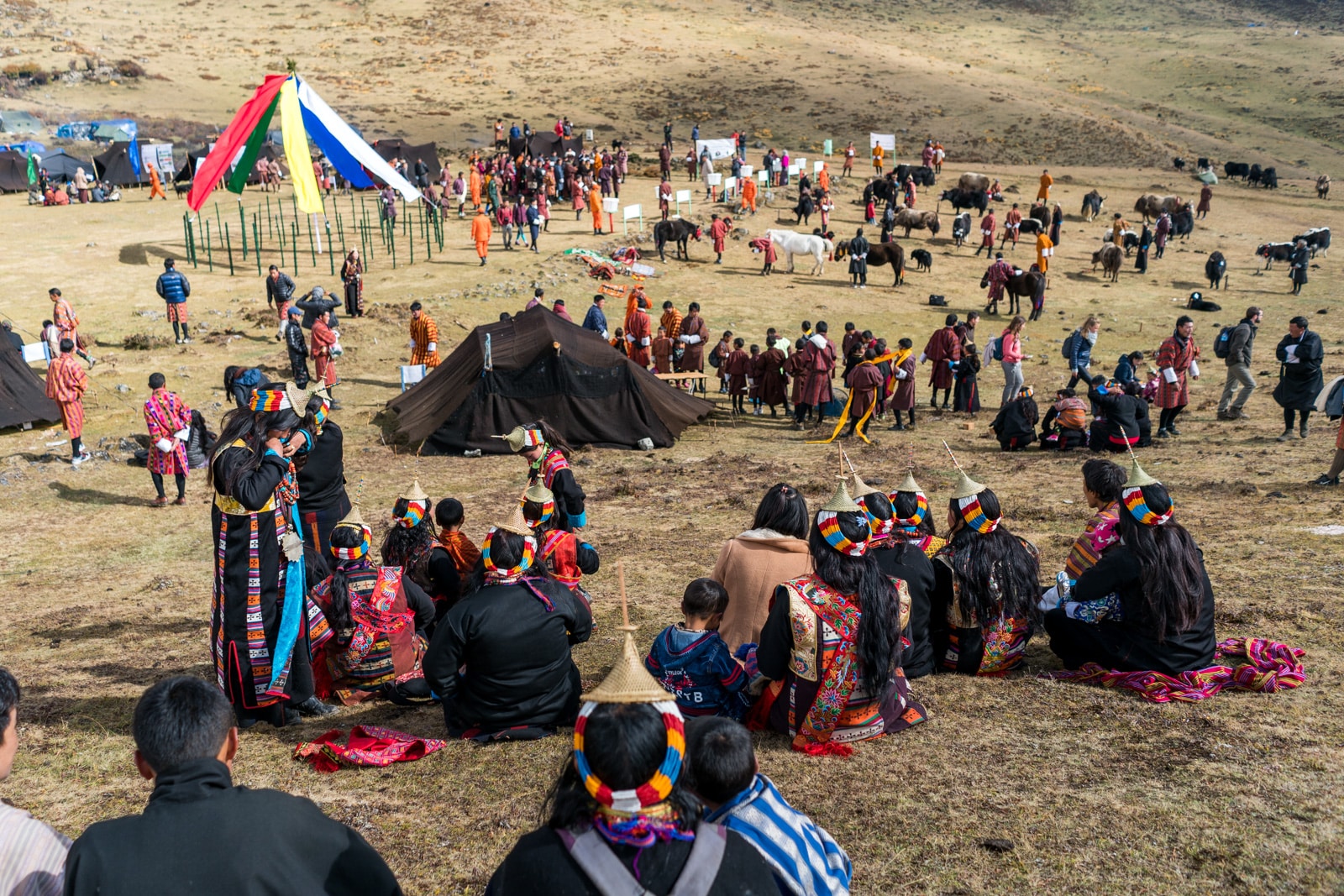
There were all kinds of activities going on at the Royal Highlander Festival at any given moment. Rather than stress over what to see, we just joined the crowds and waited to see what happened.
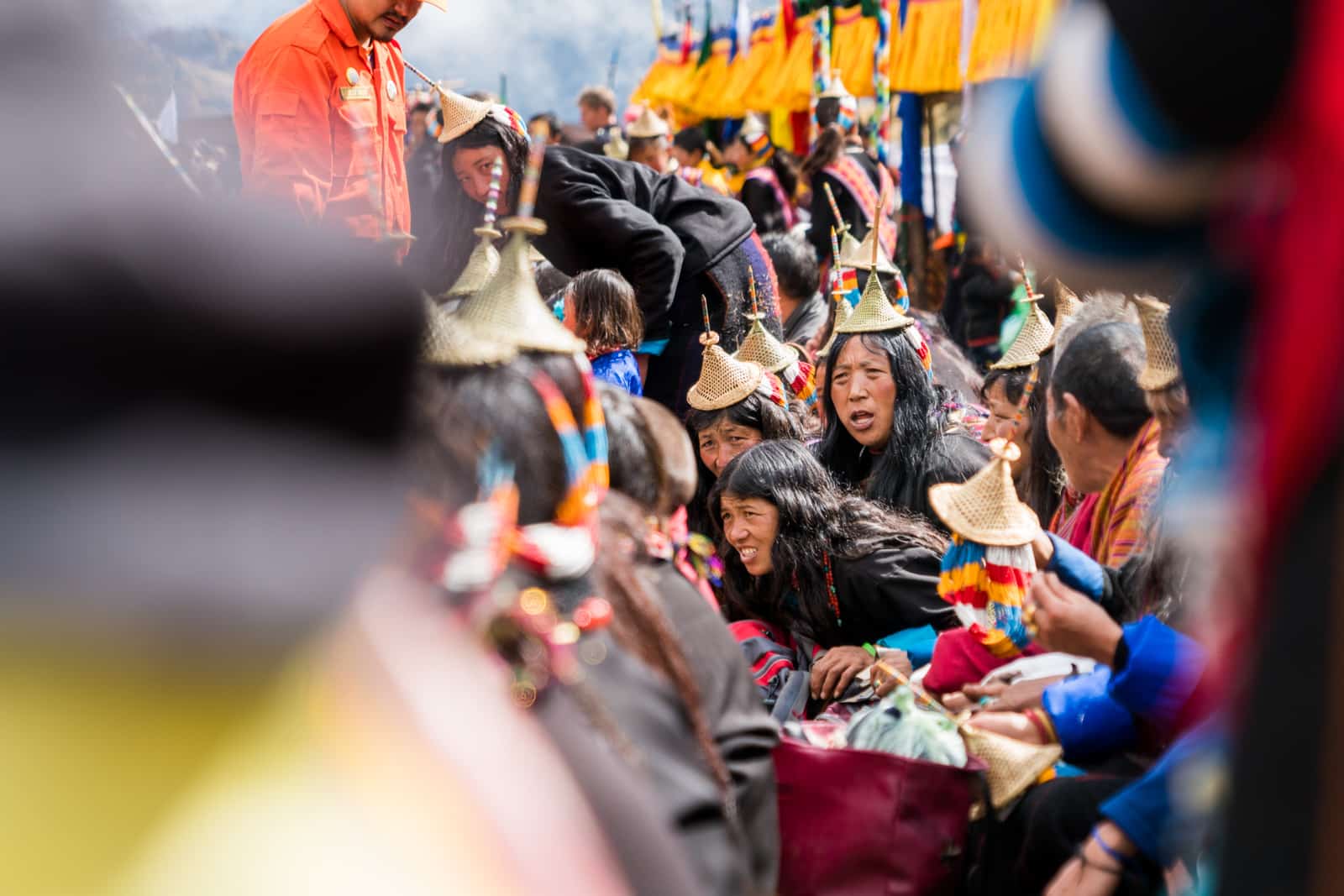
(The crowds were pretty into it, so all we had to do was follow the noise!)
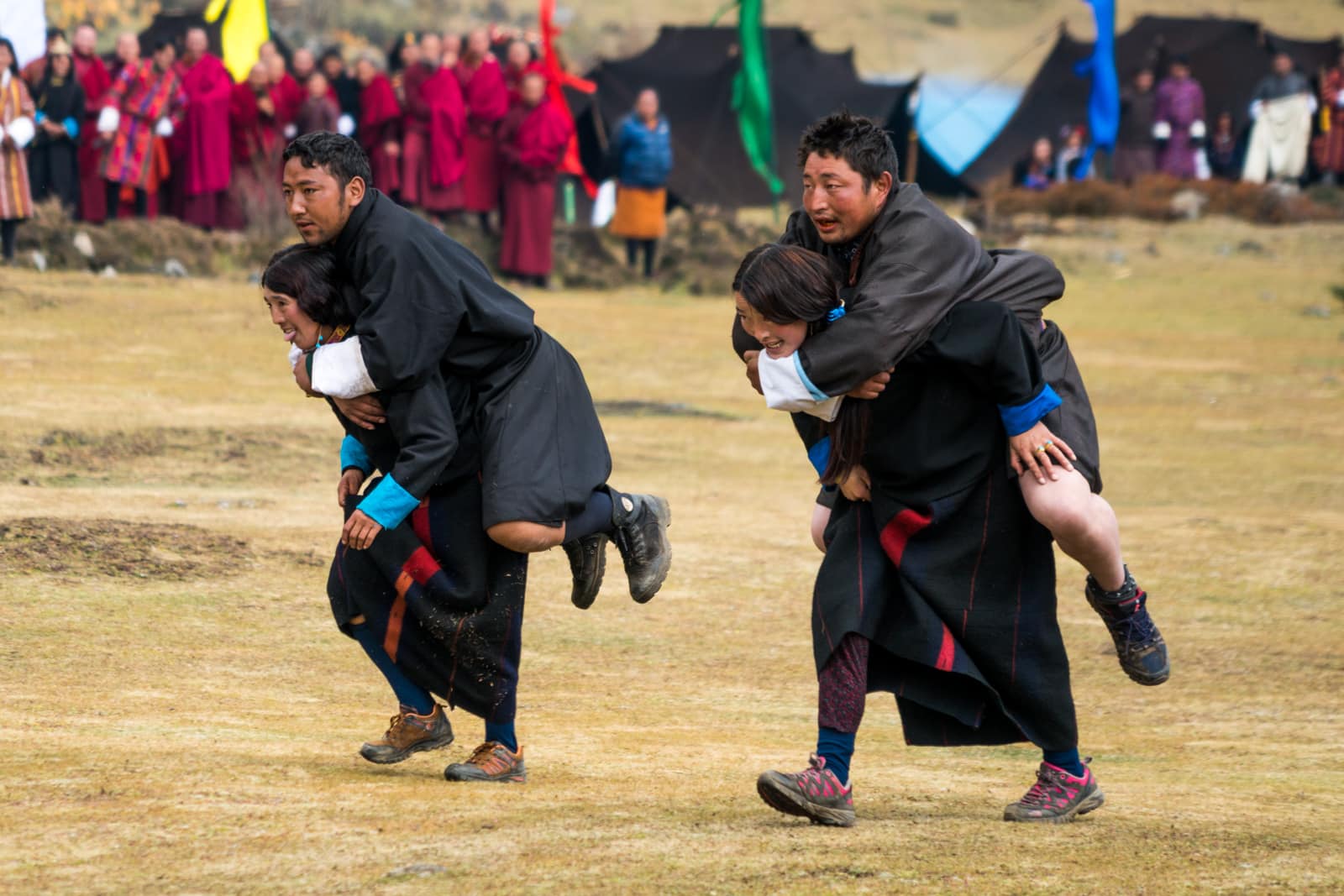
From horse races to comedy shows to wacky relays, there was never a dull moment at the festival.
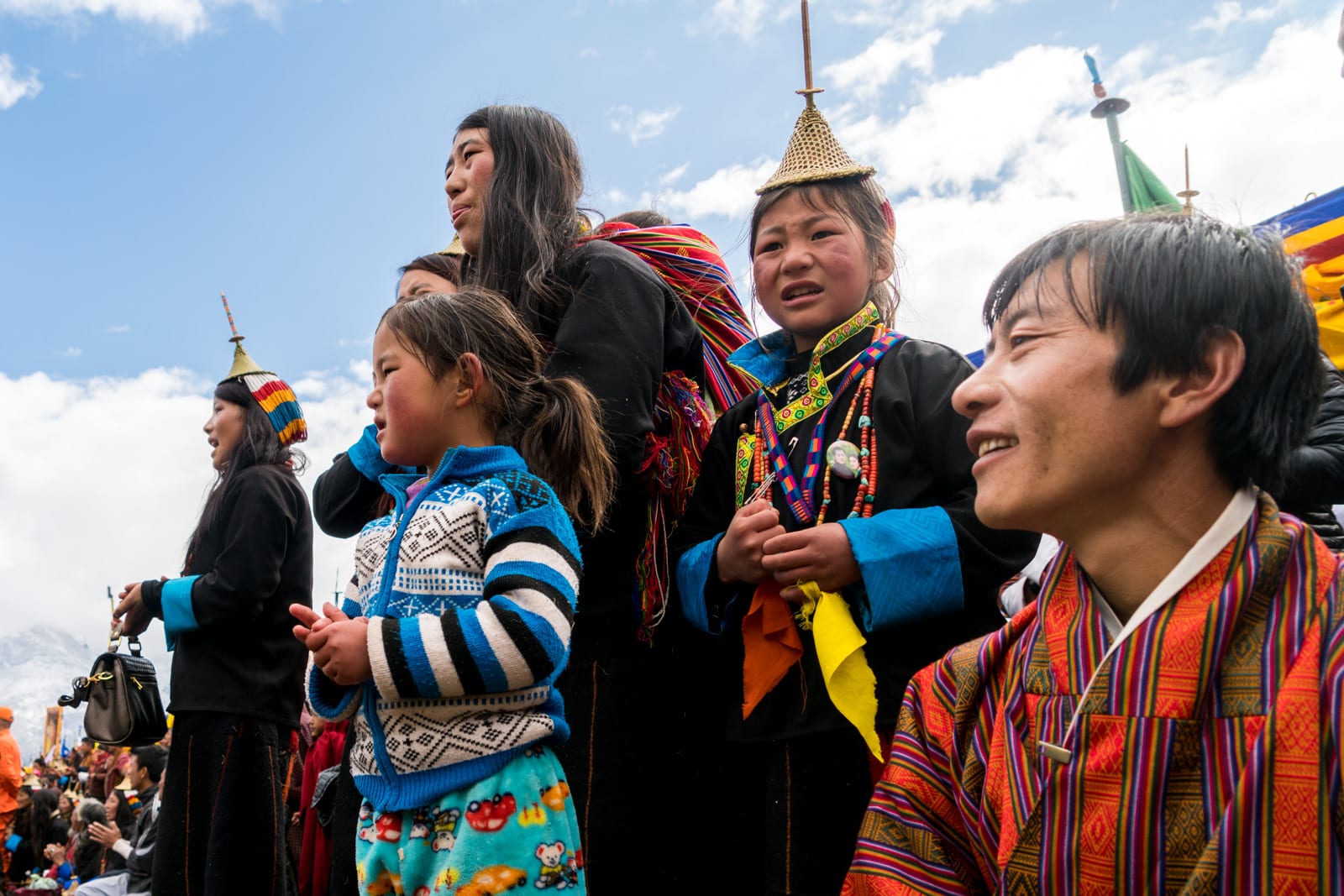
Especially when sitting with crowds of excited locals. One man was kind enough to teach us a couple of chants in the local Layap language so we could properly cheer on the contestants.
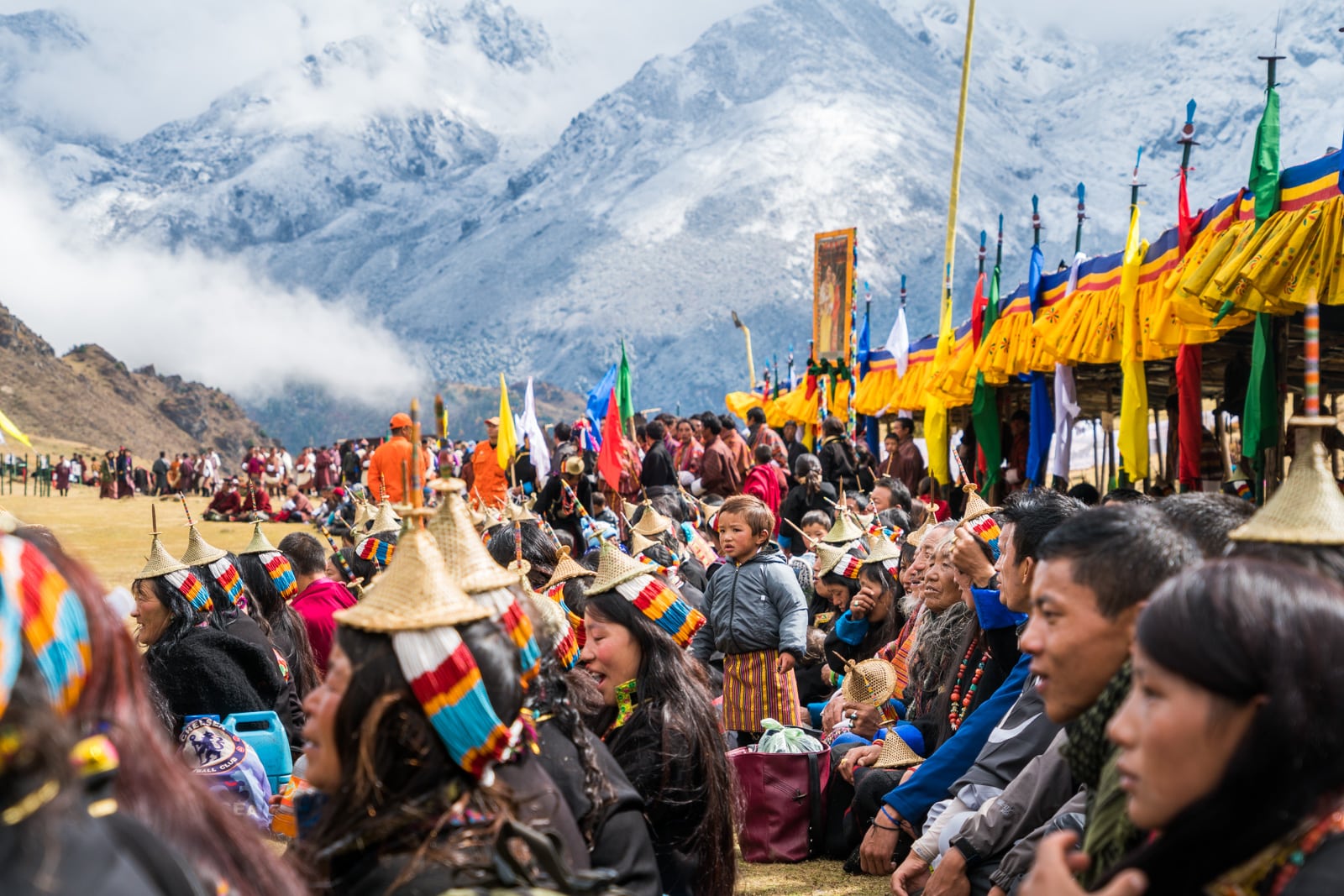
(And yes, there were crowds of people, despite the remote location!)
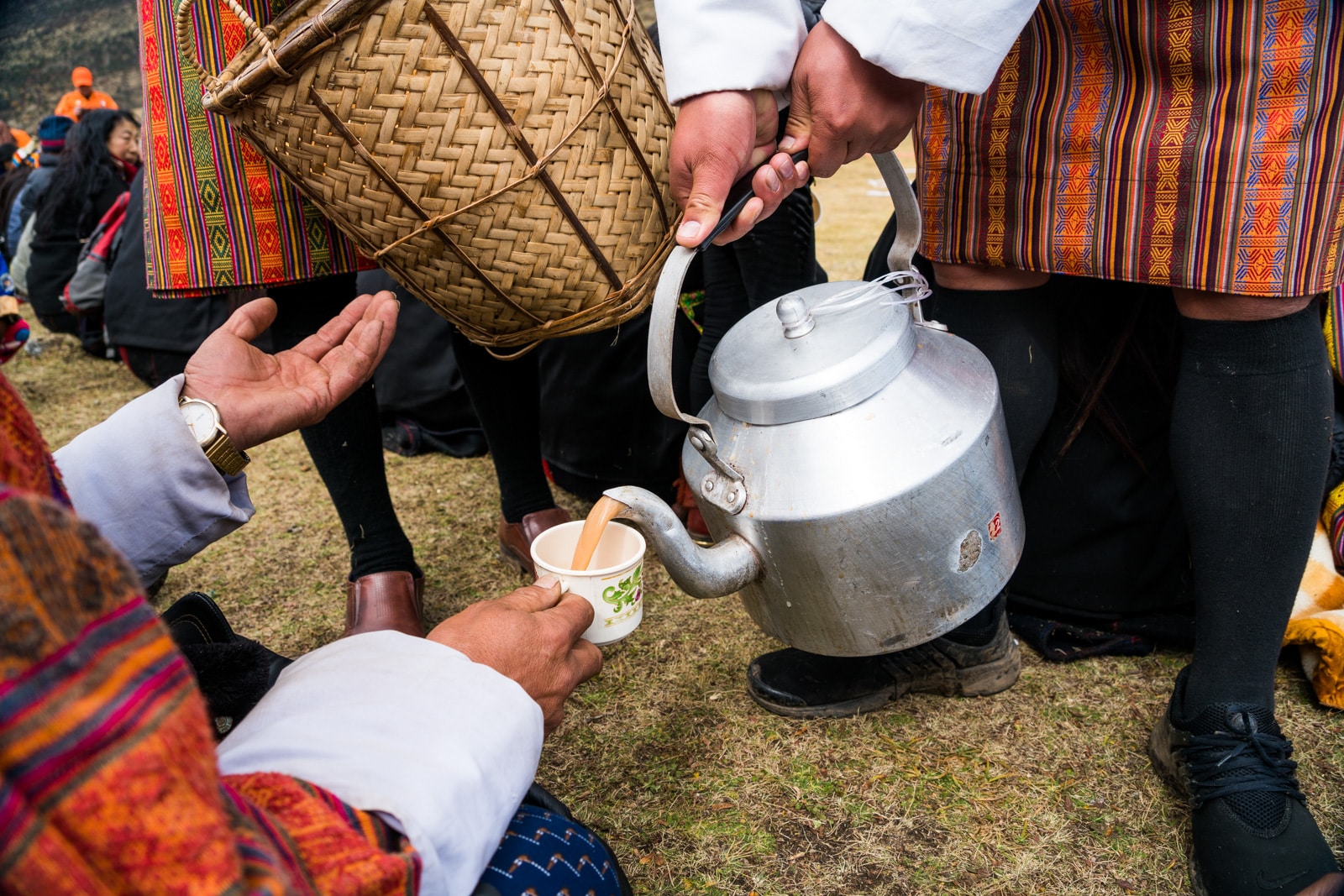
To keep up the crowd’s energy, volunteers periodically came around with pots of tea and baskets of fried biscuits to snack on.
Tip: Bhutanese people always bring a cup (and, ideally, a bowl) to festivals to capitalize on the free refreshments. Do follow their example!
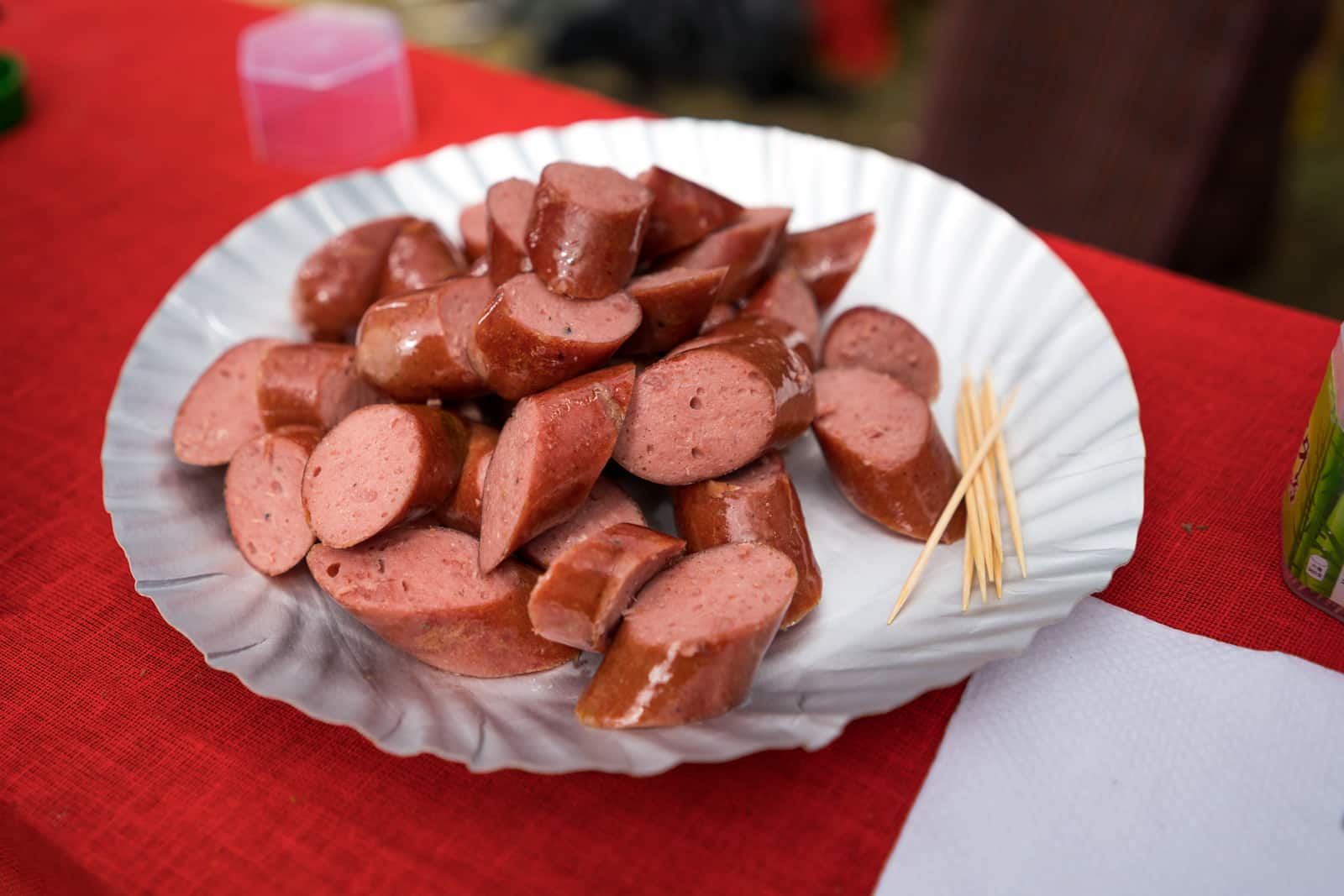
If tea and fried bits weren’t your jam, there were plenty of other kinds of food for purchase at the festival, ranging from spicy Tibetan momos to hot yak sausages.

For those who like going full circle: after enjoying plates of yak sausage, you could stroll back outside to admire living yaks (… and ponder how good they taste).
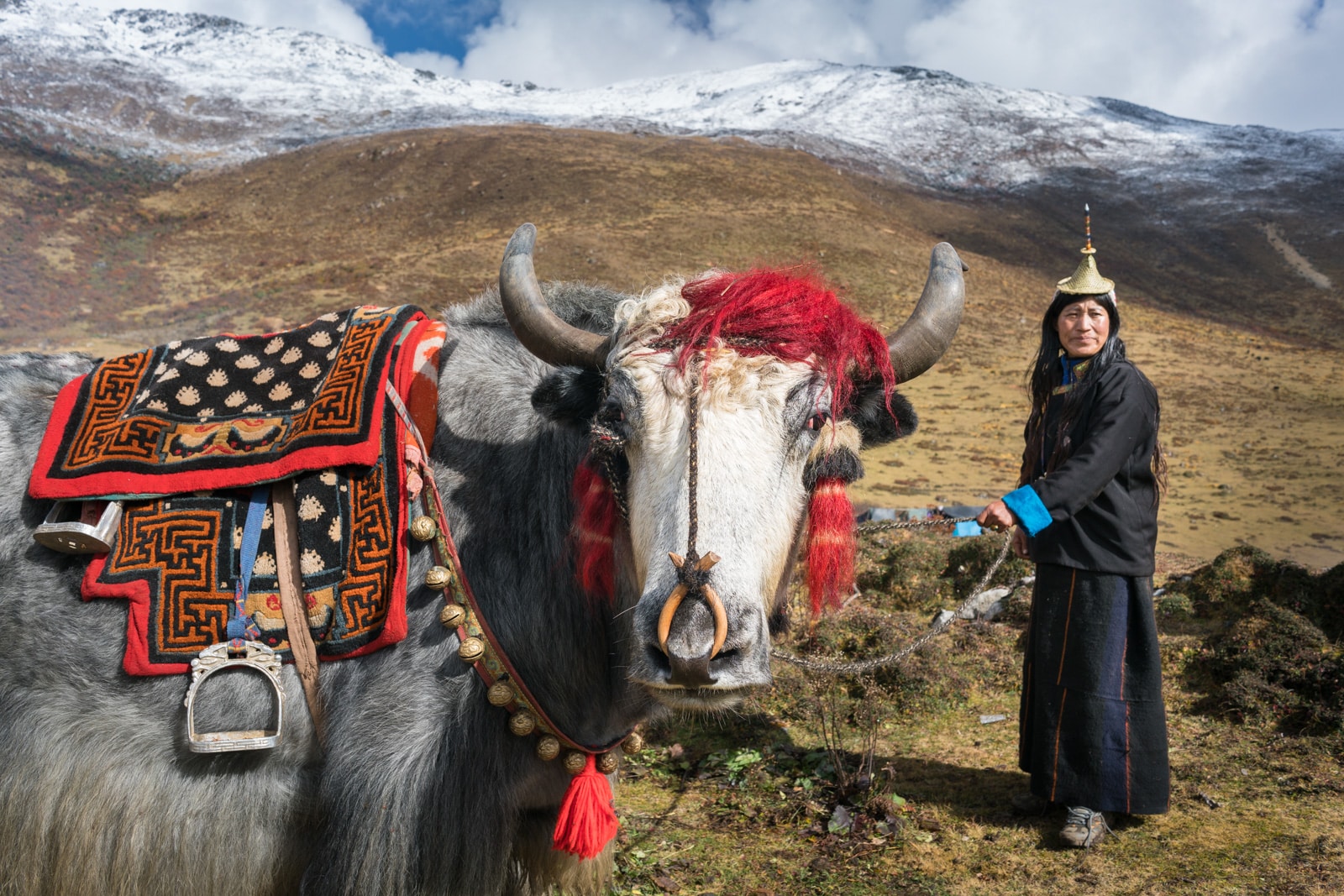
Many people brought their animals to the festival for livestock competitions. Others, like this Layap lady, brought animals along so visitors could try riding them.
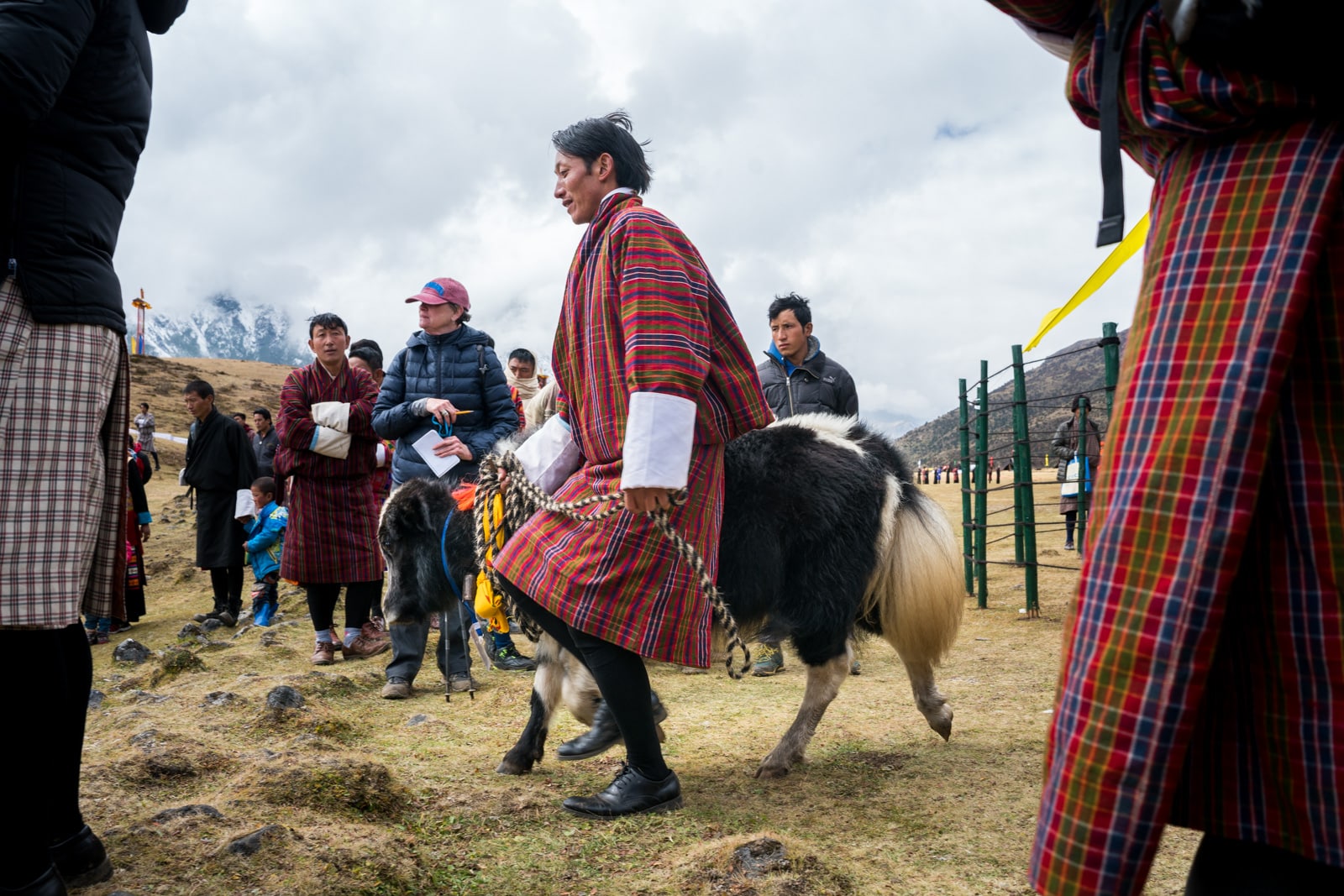
Whether for rivalry or revelry, all the animals were quite the spectacle!
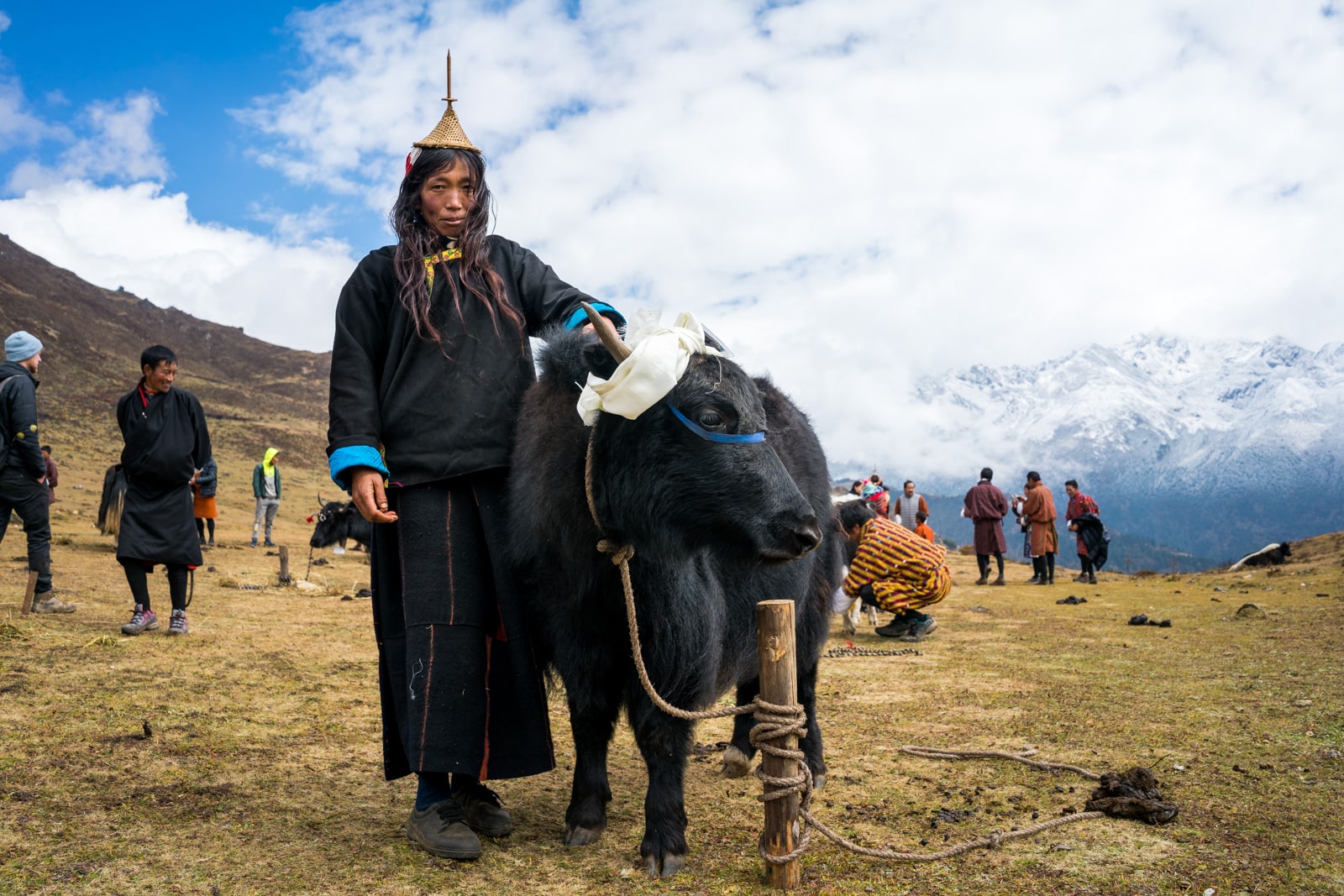
The best part: all of the animals’ owners were happy to pose with their creatures for snap-happy festival guests.
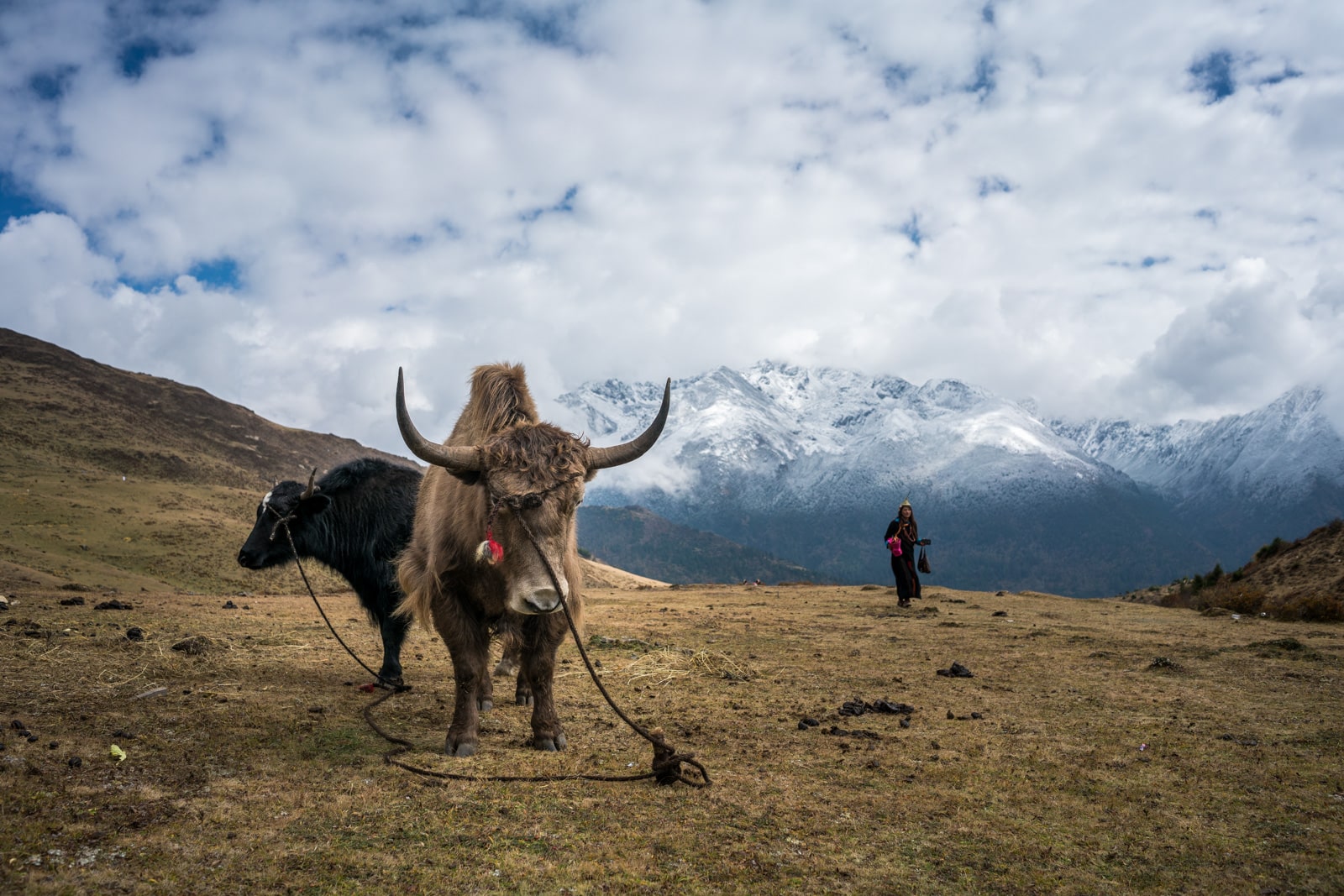
The animals themselves weren’t too bothered by cameras, either.
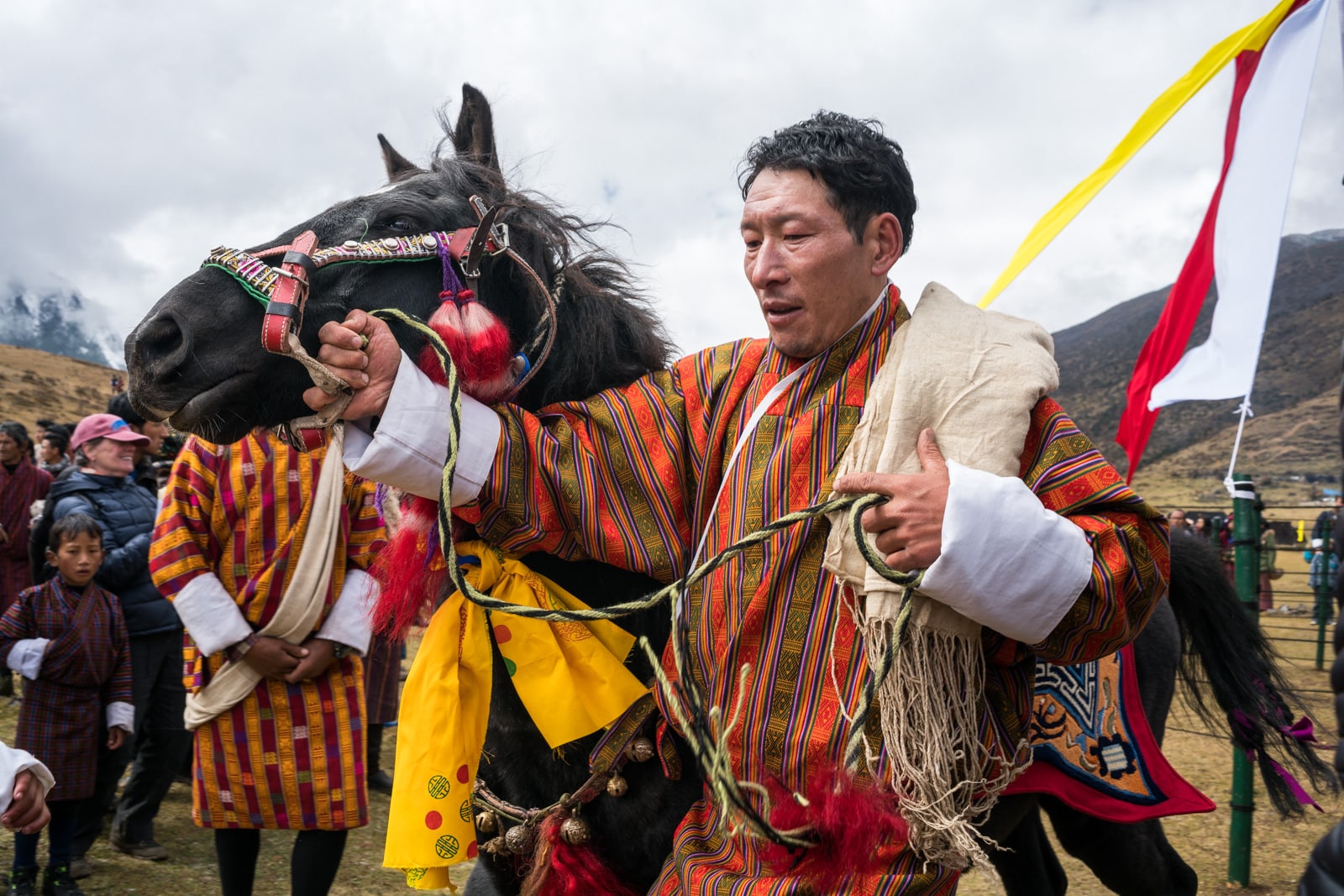
And there were plenty of photo ops as the livestock competition prizewinners lapped the show area for a final hurrah.
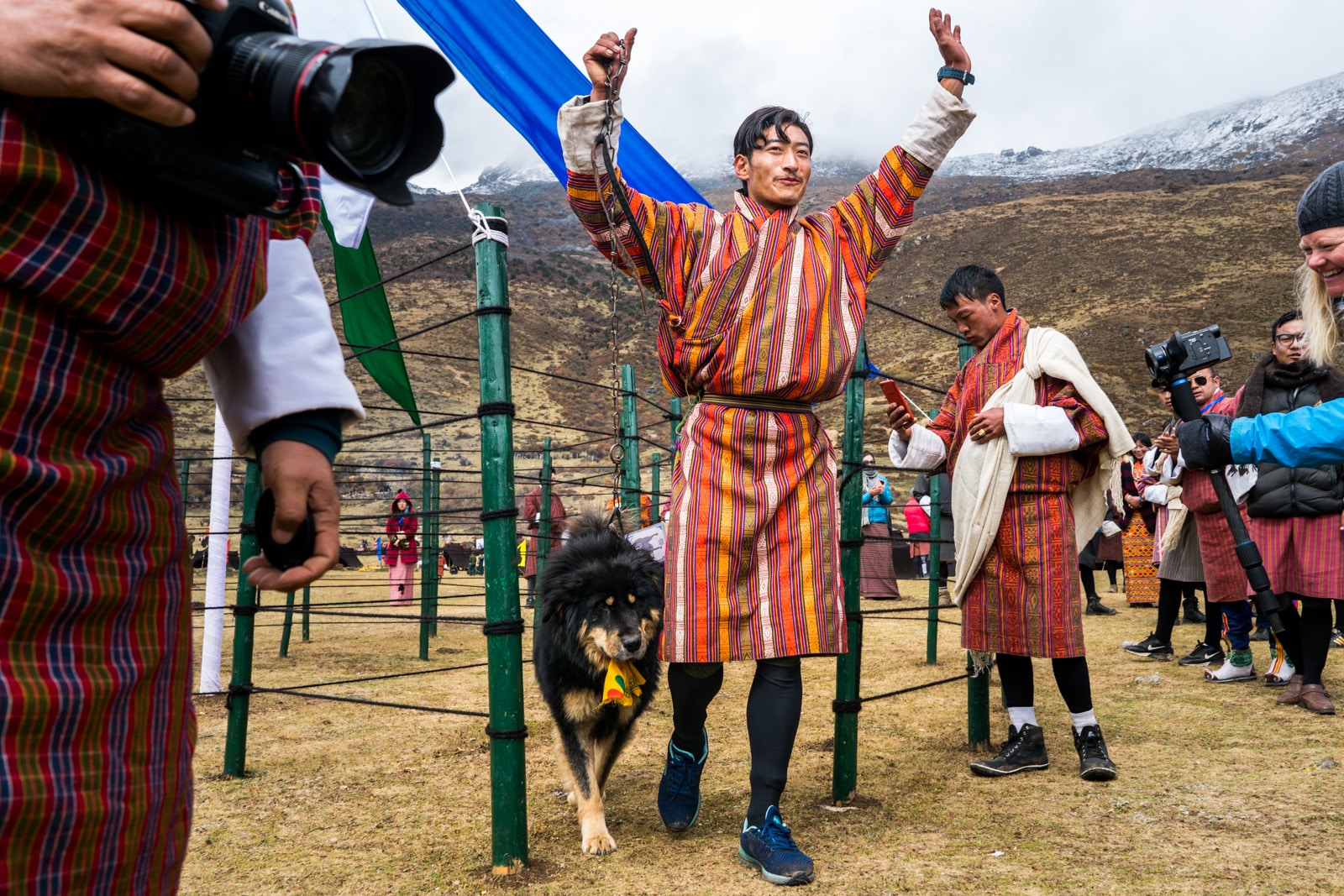
Yaks and horses stole the show, but there were a handful of hunting dogs and cows on display, too.
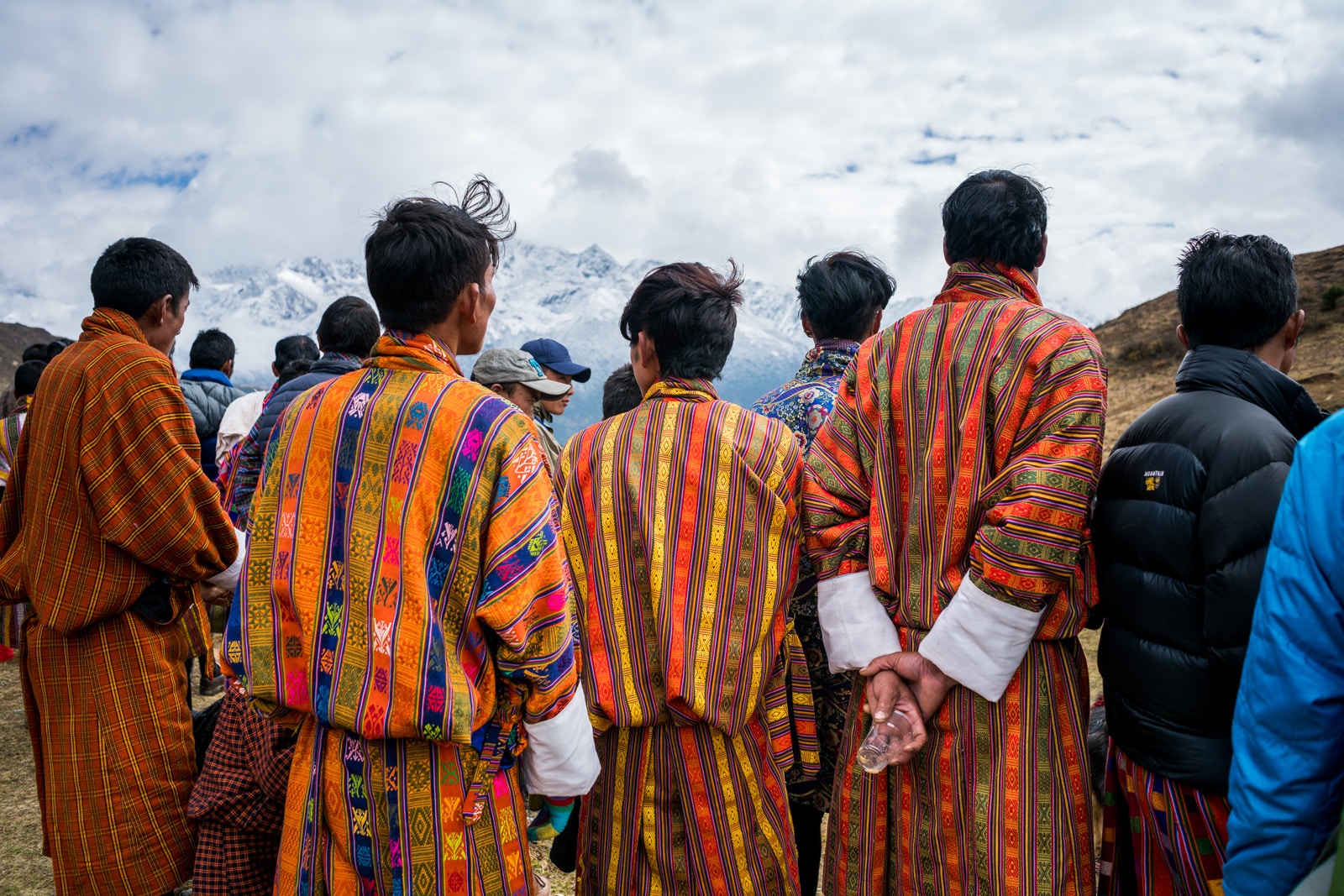
Despite the flurry of furry activity, I found myself people watching above all else. How could I say no to these colorful gho? (Traditional male Bhutanese dress)
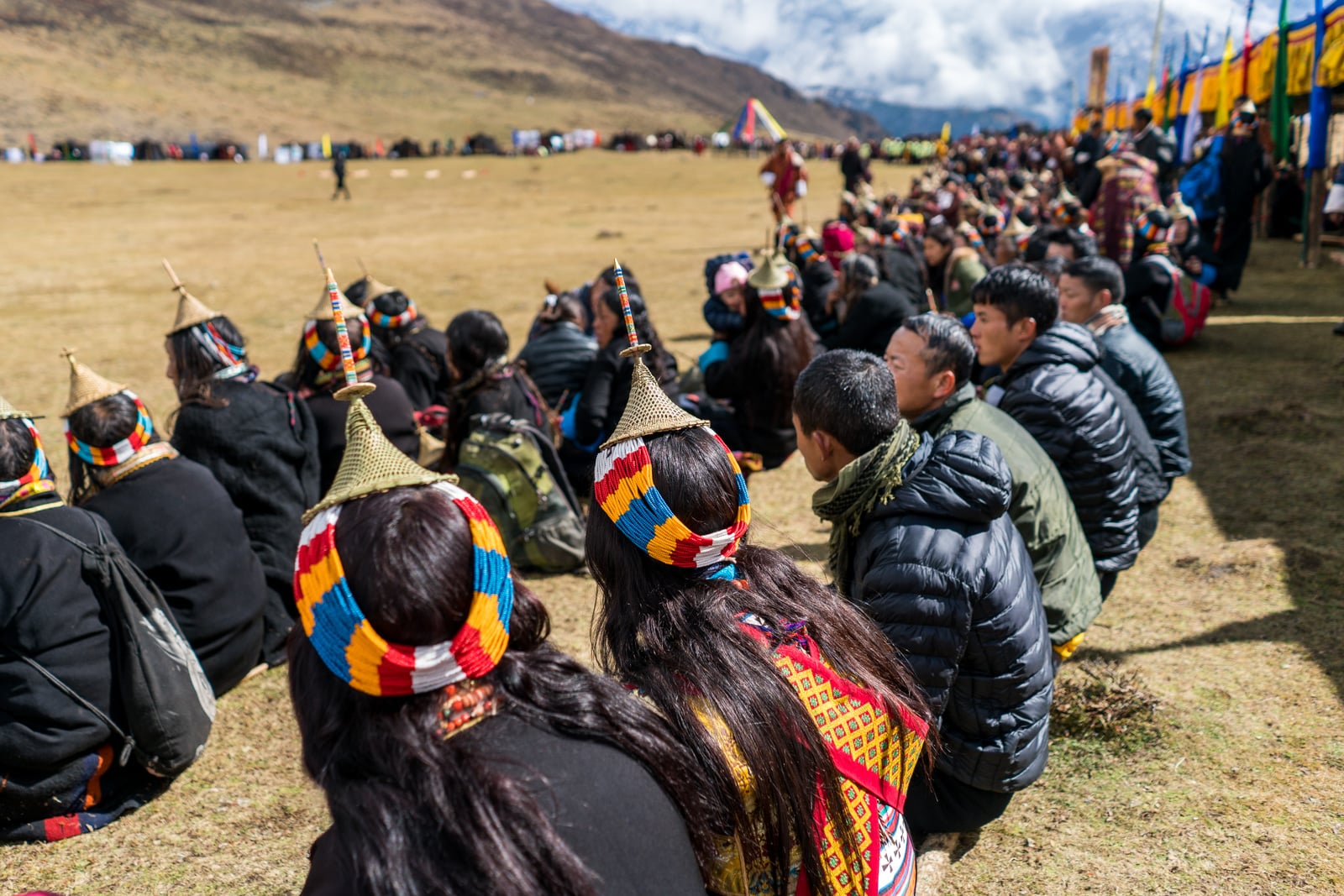
… or the brilliantly beaded headdresses of the local Layap women?
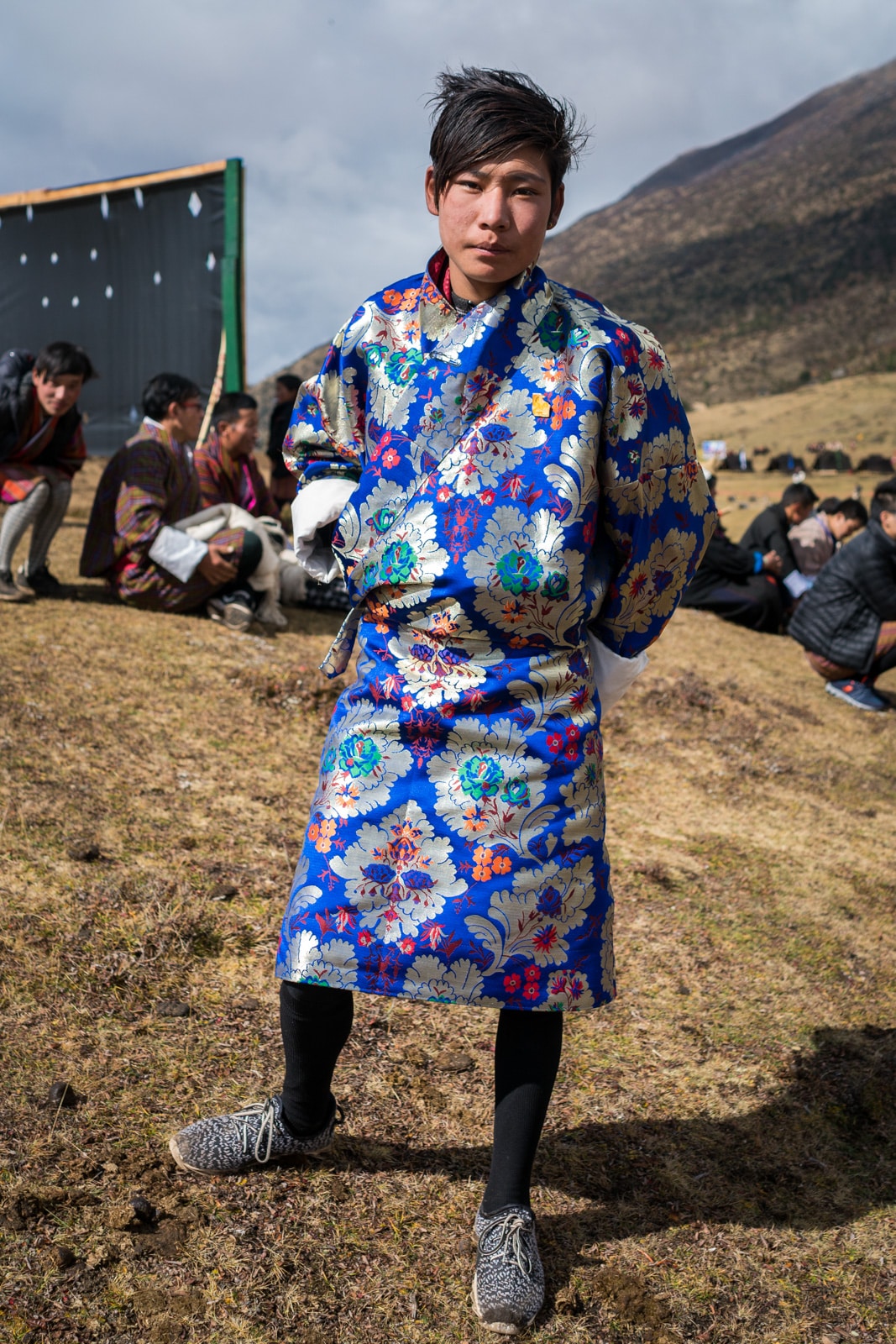
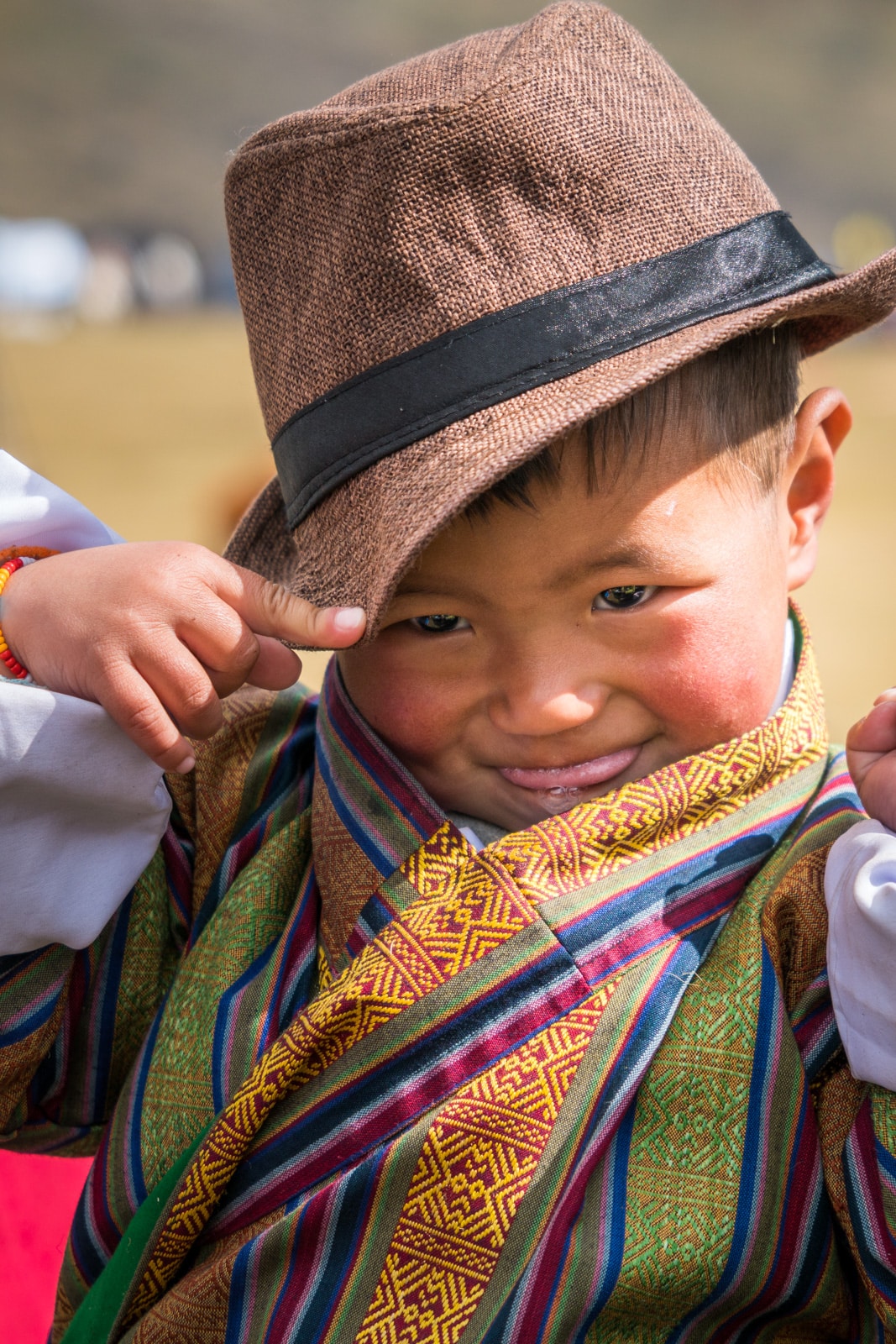
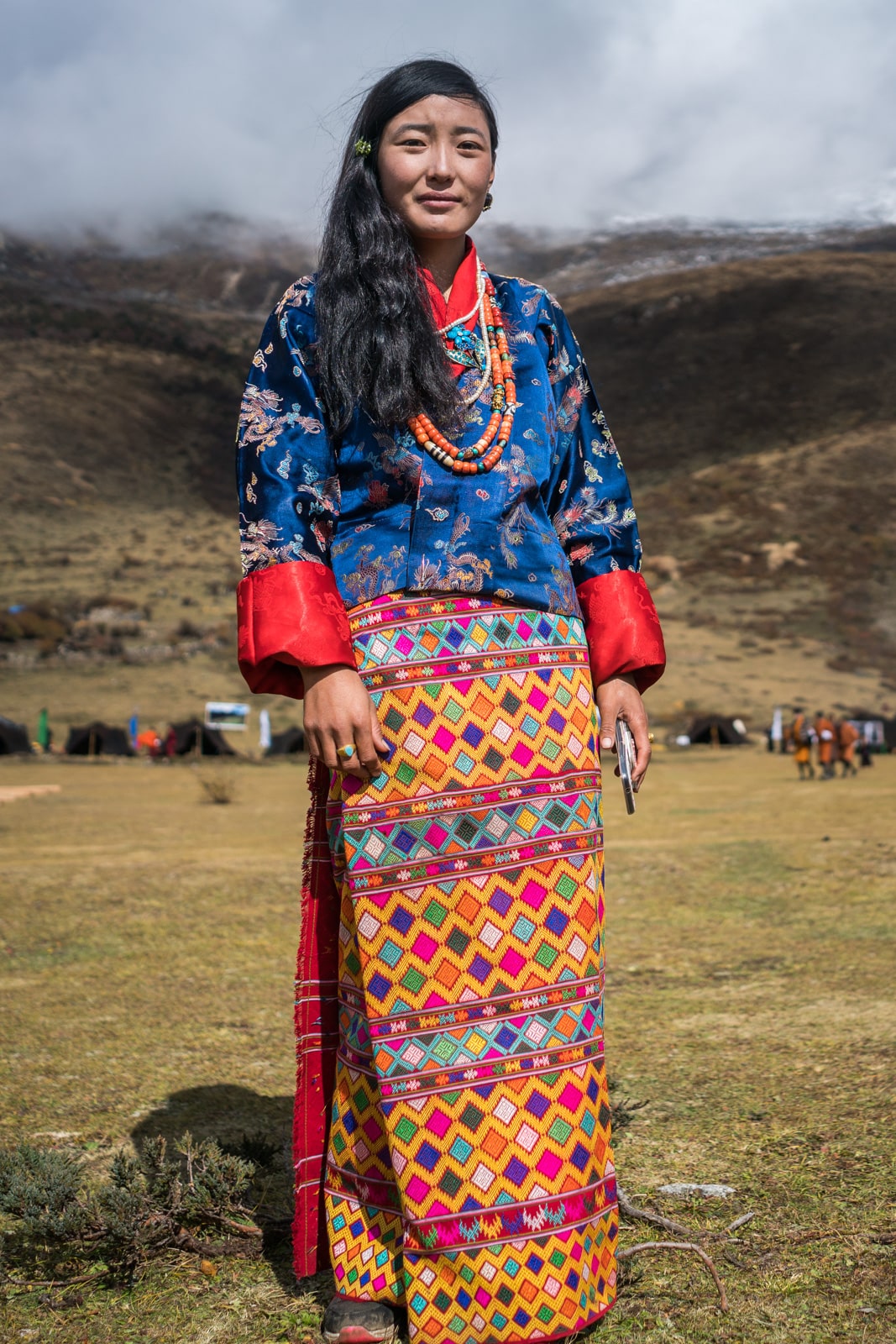
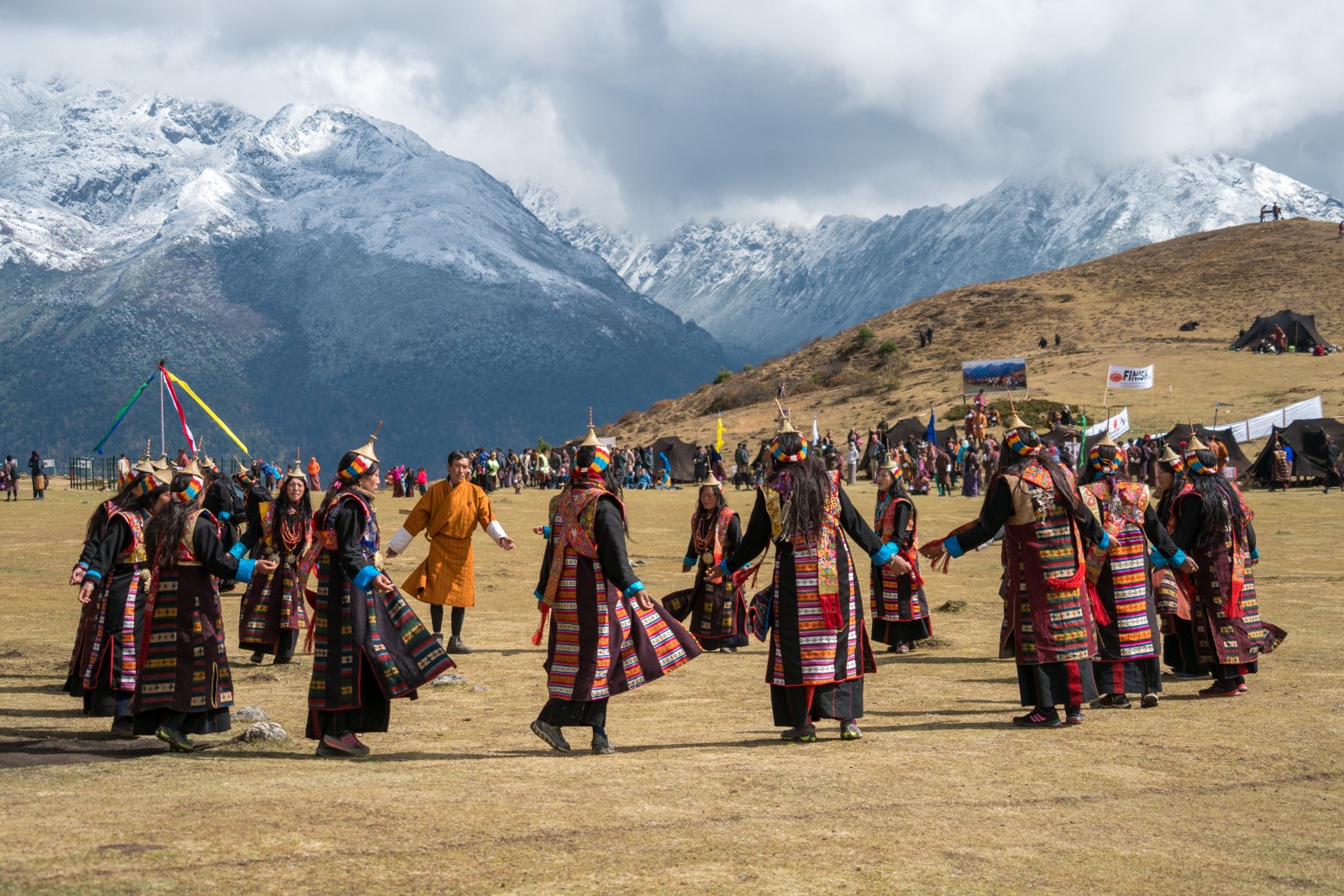
… and don’t even get me started on the textiles. *Drool.*
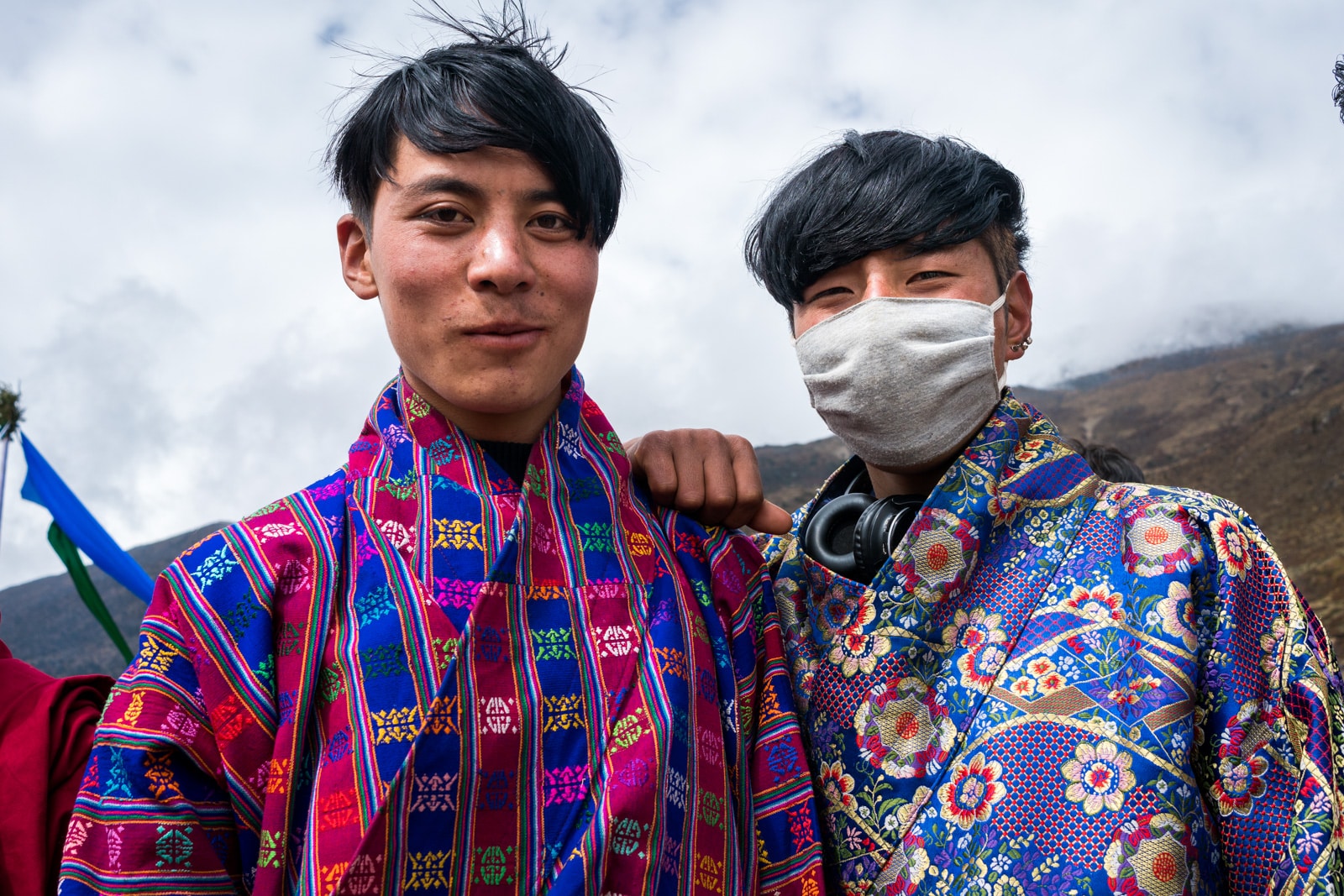
Seriously, though, just look at their gho. 98.7% sure these are the most fly outfits I’ve ever seen.
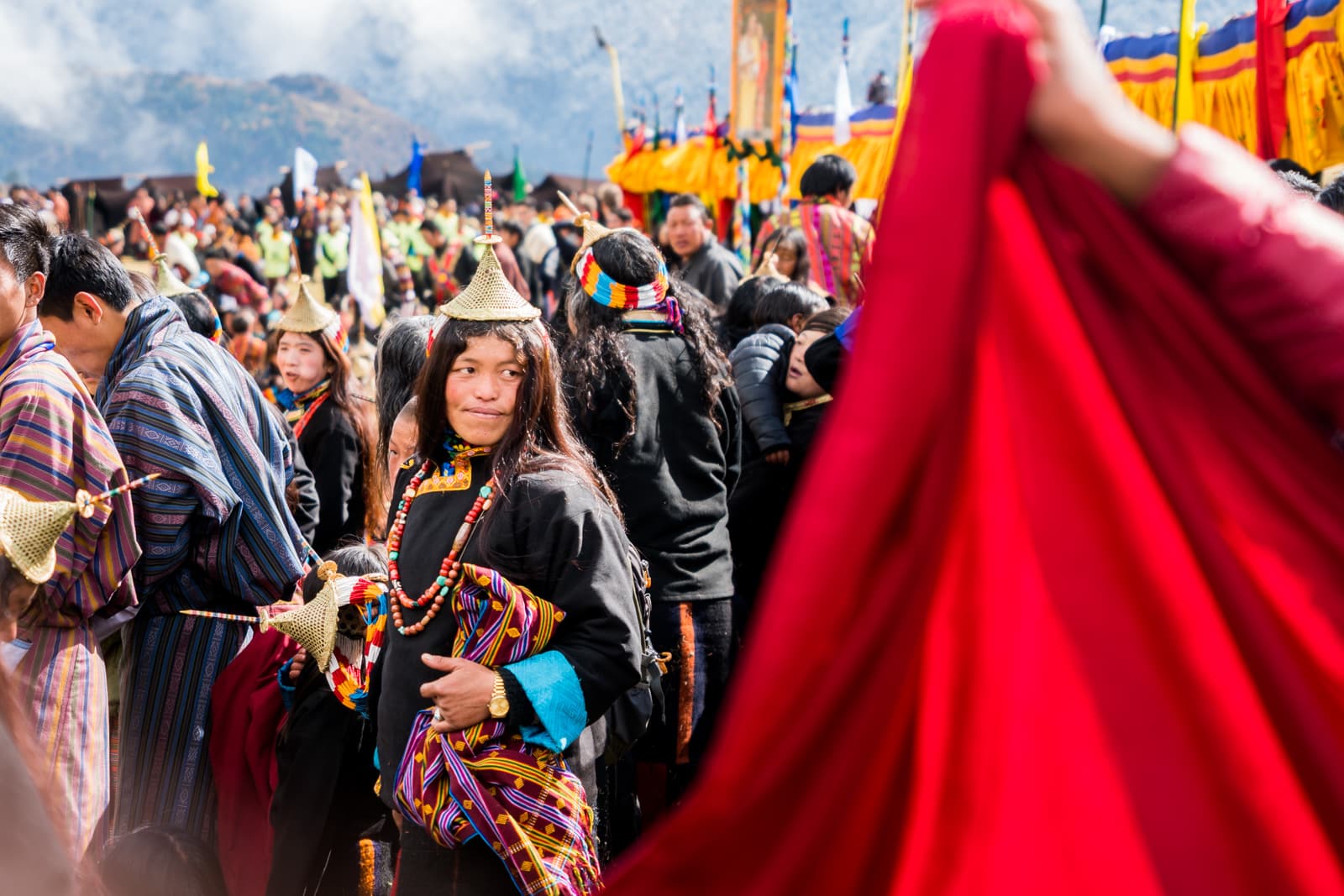
And these people aren’t exceptions—all the locals at the festival were dressed in their best!
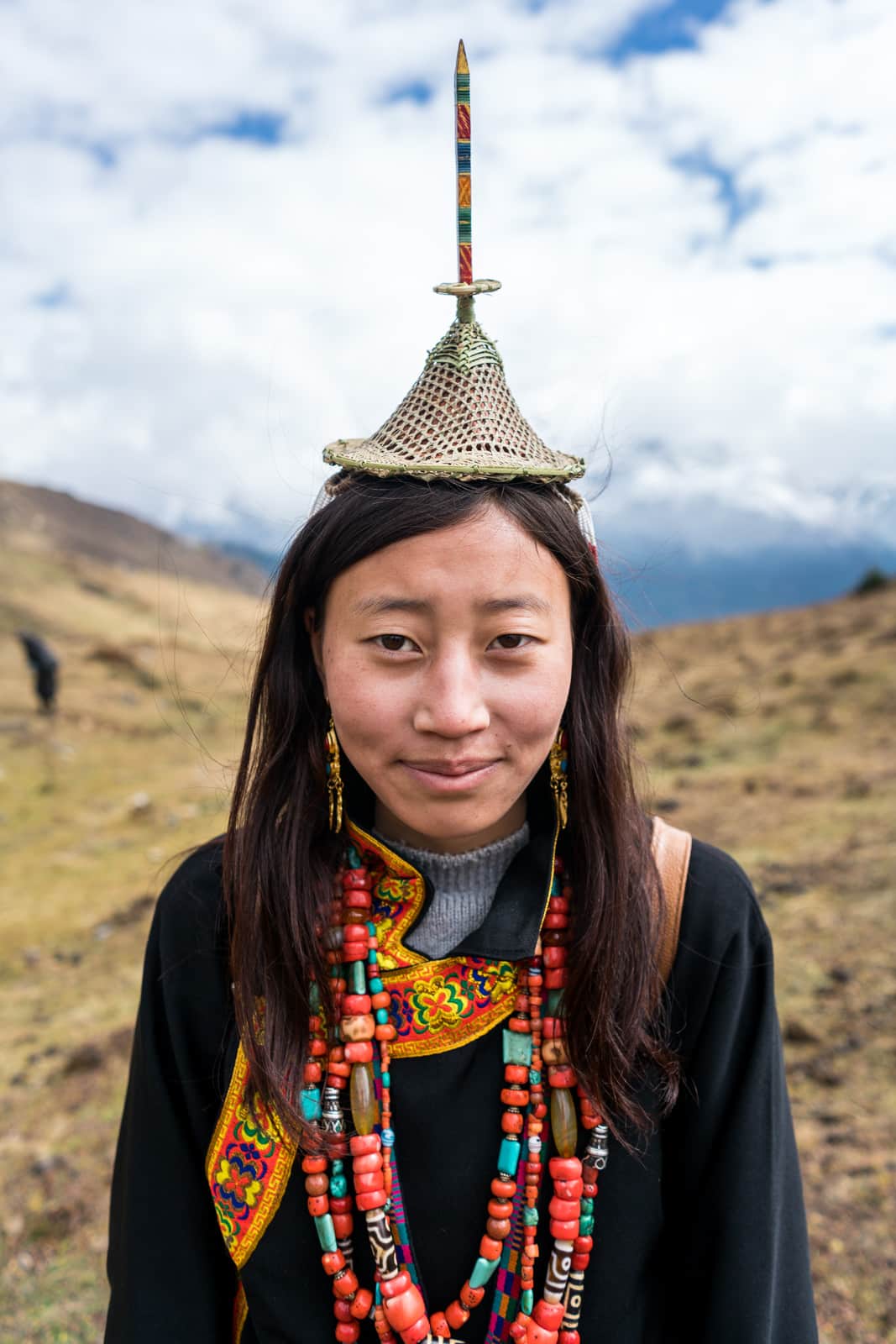
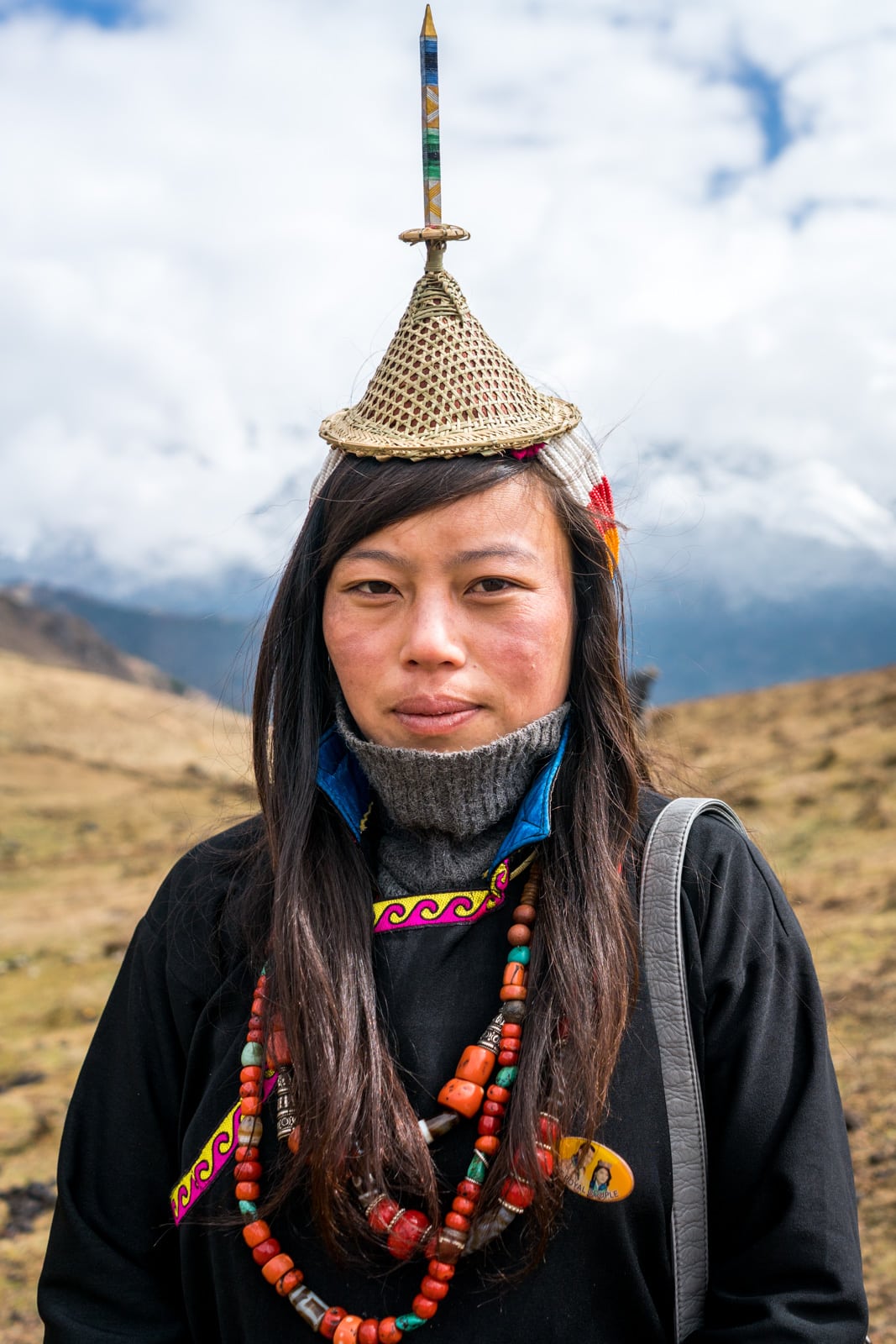
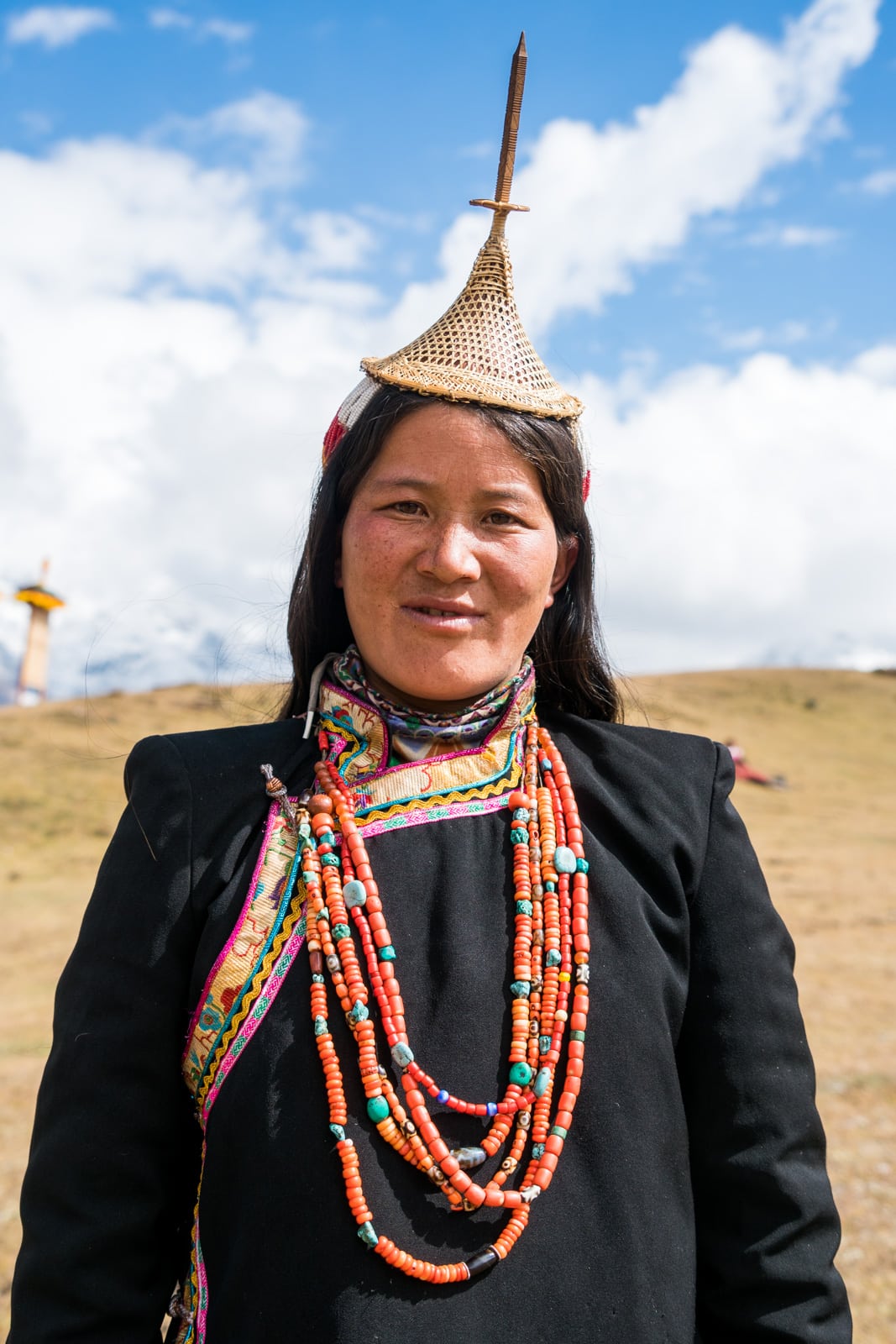

Local Layap people composed most of the crowd…
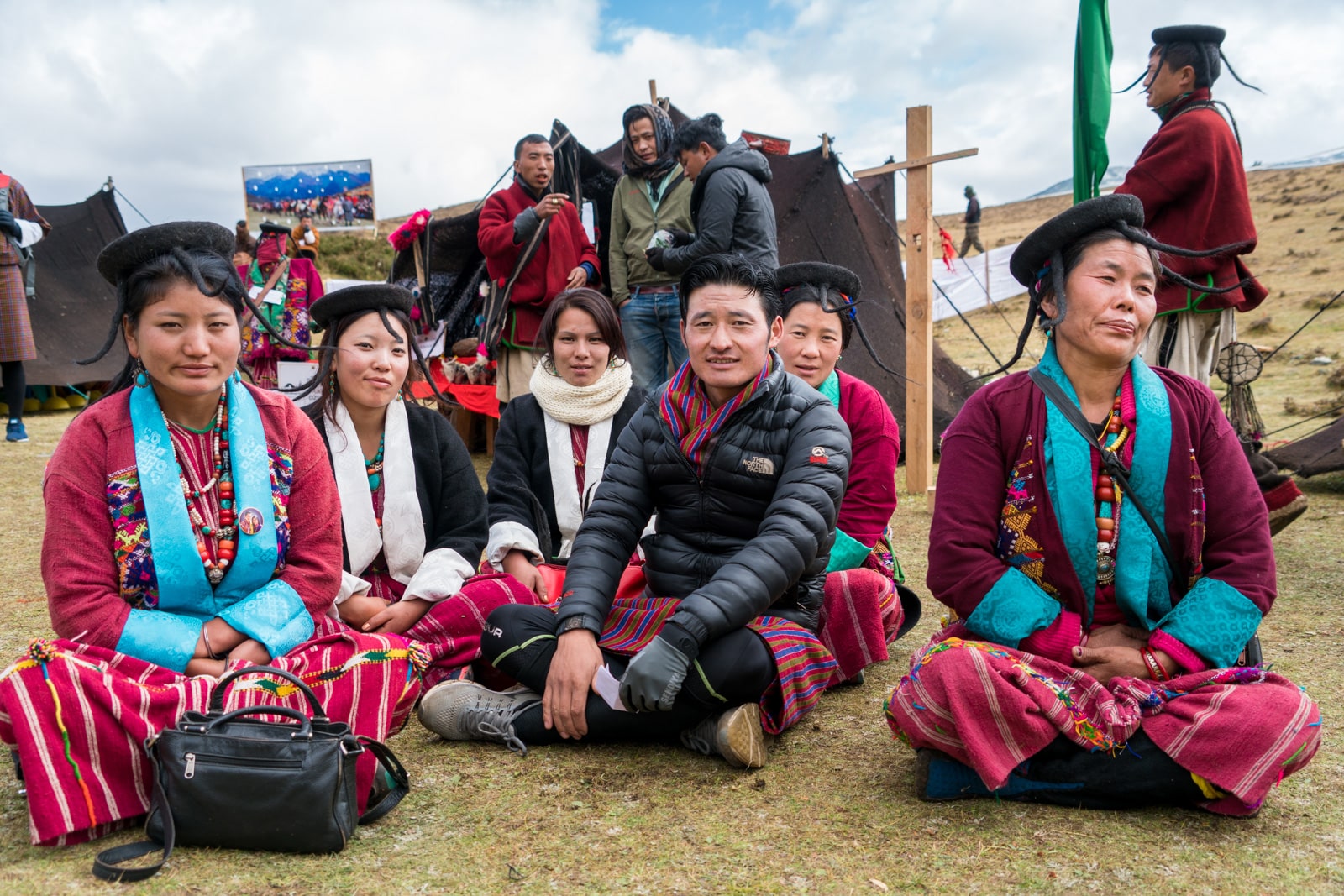
… but other ethnic groups could be spotted if you were attentive, such as this family of Monpa people. Monpas live in the far east of Bhutan, and there’s a small Monpa population in the west of Arunachal Pradesh near Tawang.

Spiky yak hair hats are the most iconic part of the Monpa ensemble, but their embroidered vests are what caught my eye!
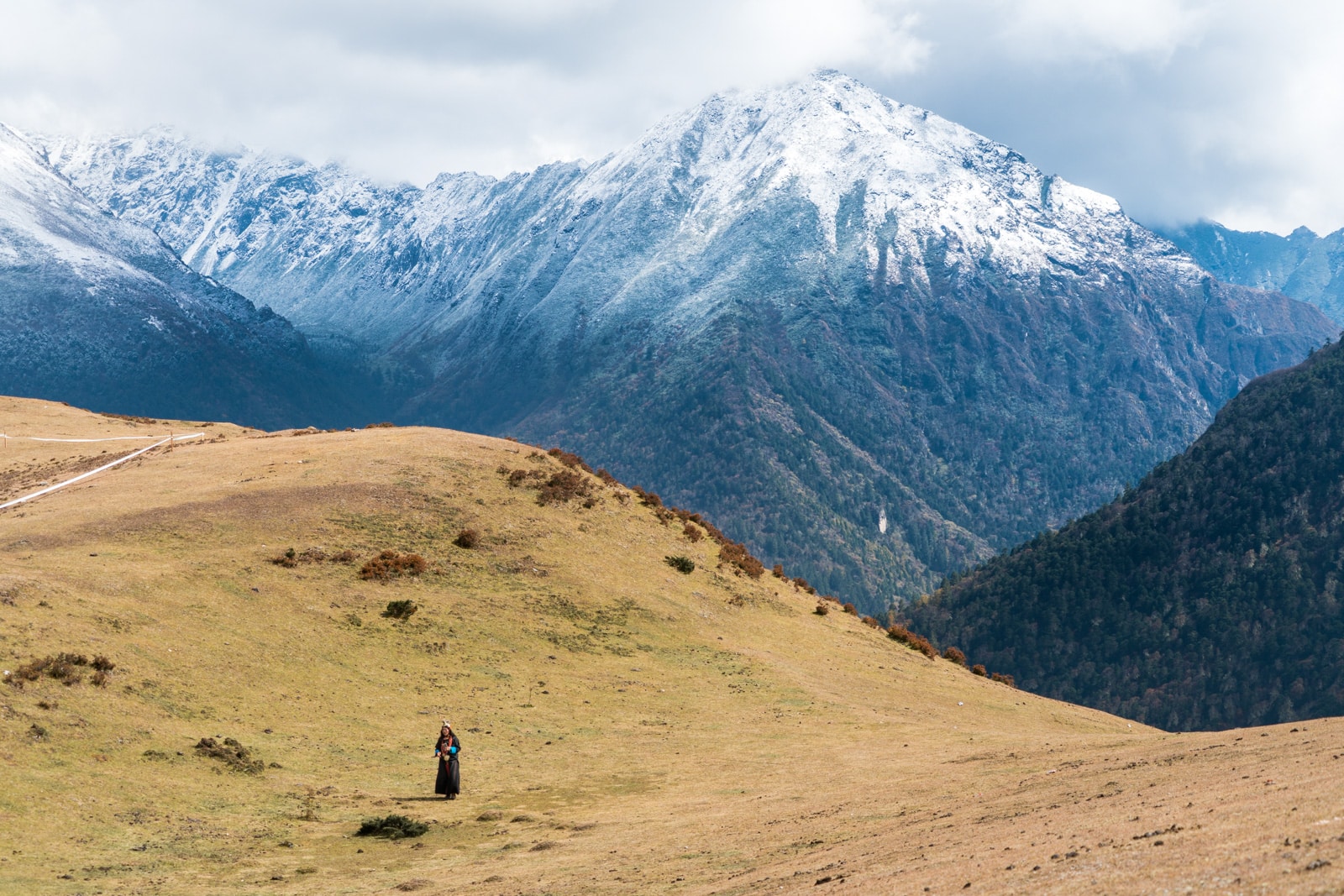
As the festival wound down and people began to head home, we retreated to the festival’s fringes to enjoy the festival’s grand finale: the location. As we stood admiring the views from a hill, a friendly man from Thimphu, Bhutan’s capital, pointed out a mountain just above the festival. Apparently there’s a beautiful alpine lake just a few hours’ walking from the festival grounds!
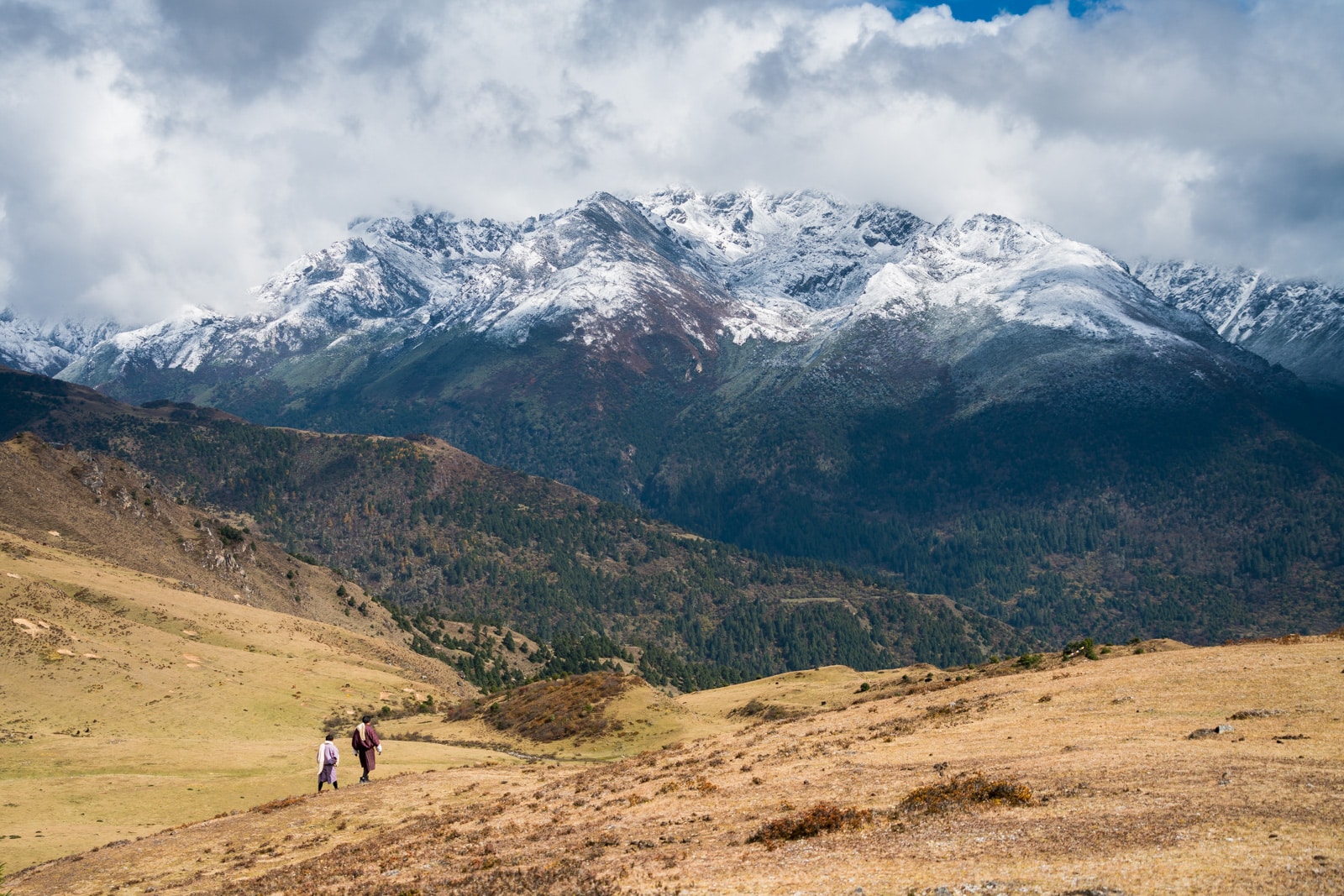
Despite our history with epic festivals, I have no issue with saying this was the most beautiful festival location we’ve ever been to. I think you can understand why.
How to travel to the next Royal Highlander Festival in Bhutan via the Gasa – Laya trek
If you have eyeballs, we assume you’re now convinced you need to attend the 2018 Royal Highlander Festival. (We know we are.)
To help you plan your trip, here’s what you need to know about traveling to the Royal Highlander Festival in Bhutan:
Tour
Unless you’re from India, Bangladesh, or the Maldives, you’re required to visit Bhutan through a tour company. sponsored our trip to Bhutan, and they’re one of very few tour companies who knew about and brought tourists to the 2017 Royal Highlander Festival (to the impressed surprise of many locals). We had a great time traveling with them, and can highly recommend their services. Make sure to book ahead of time, as tours during the high season (October) book up fast!
Accommodation
There are opportunities for both camping and basic guesthouses/homestays in Laya. Tour companies can arrange accommodation based on your preferences.
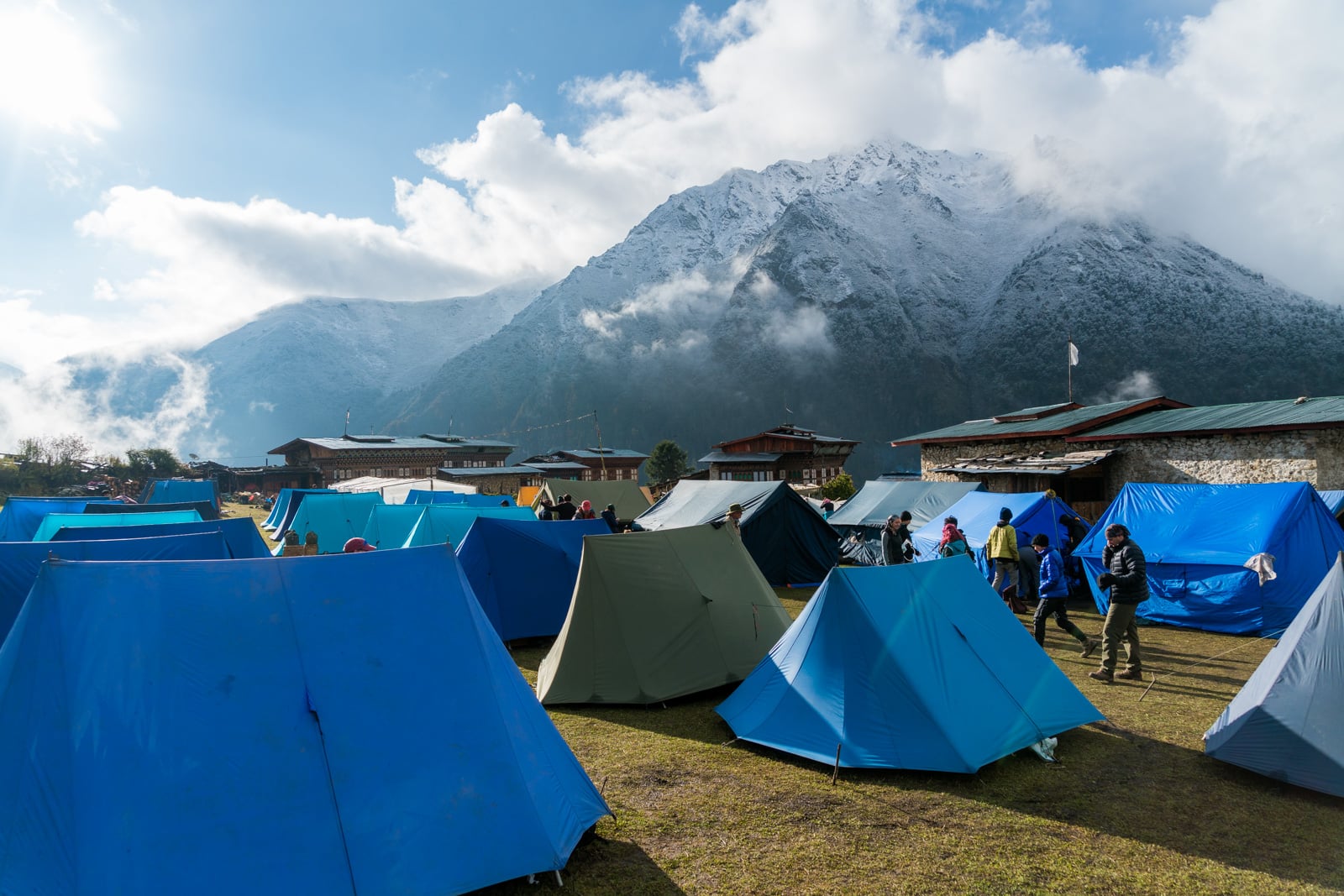
Our camp in Laya.
Date
Once you’ve committed to a tour company, make sure to set the date in your calendar! The next festival will occur sometime around the 23rd of October 2018, though dates can always change. Count on the festival lasting two days, and give yourself several days before and after for acclimating to the altitude and trekking up to the festival grounds. And a few more days to explore the rest of Bhutan because duh.
Location
The first and second Royal Highlander Festivals were held in Laya, though there are rumors that future festivals will be held in other highland settlements. Stay tuned—we’ll update when we know more.
Trekking
If the festival is held in Laya, you must to trek to the festival grounds via the Gasa – Laya trek. Unless you want to shell out for a helicopter, that is. Most locals trek to the festival. Even the King of Bhutan trekked up in 2017!
The Gasa – Laya trek is a high-altitude trek of moderate difficulty on very uneven terrain at times, and involves around 1,500 – 2,000 meters of vertical ascent. Horses are available for carrying luggage along the route. Our trekking route began from a starting point outside Gasa, and took two days for our group of generally fit, though not overly athletic people. Keep in mind that weather can be quite unpredictable in the mountains, and inclement weather can slow things down significantly. These are the Himalayas we’re talking about!
Fit as you may be, if planning on doing any part of the Gasa – Laya trek, be sure to get a bit of exercise in before leaving home! Medical professionals recommend doing practice treks with a backpack on, or taking up cycling for a time. Also, walking sticks are your friends.
Resources
For more information on future Royal Highlander Festivals, check out these websites:
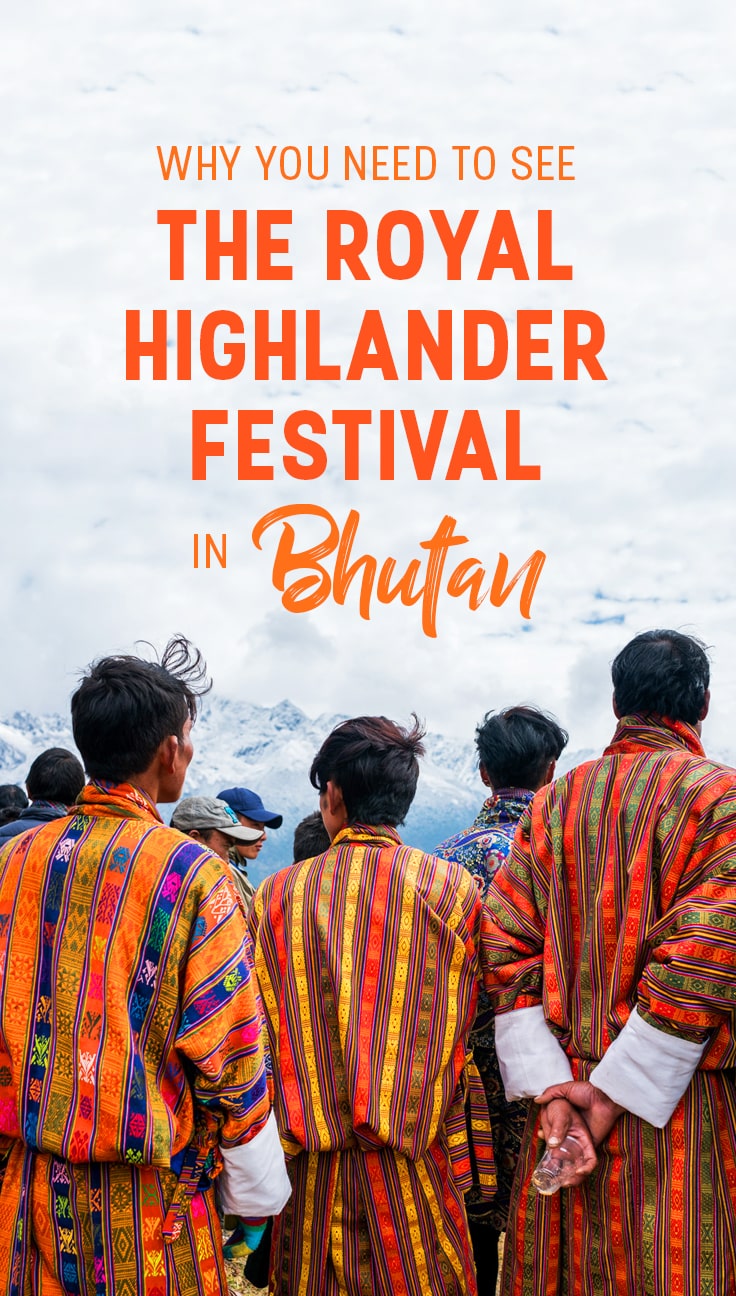
Yay, transparency! All the costs of our trip were covered by , and this Royal Highlander adventure was part of their first official tour in Bhutan. Though a young company, they’ve proven to us that they’re capable of bringing tourists to this festival, and ensuring everyone has a blast. We recommend using them to visit the Royal Highlander Festival (and the rest of Bhutan). Just remember that everyone’s experience is different, and book at your own discretion.
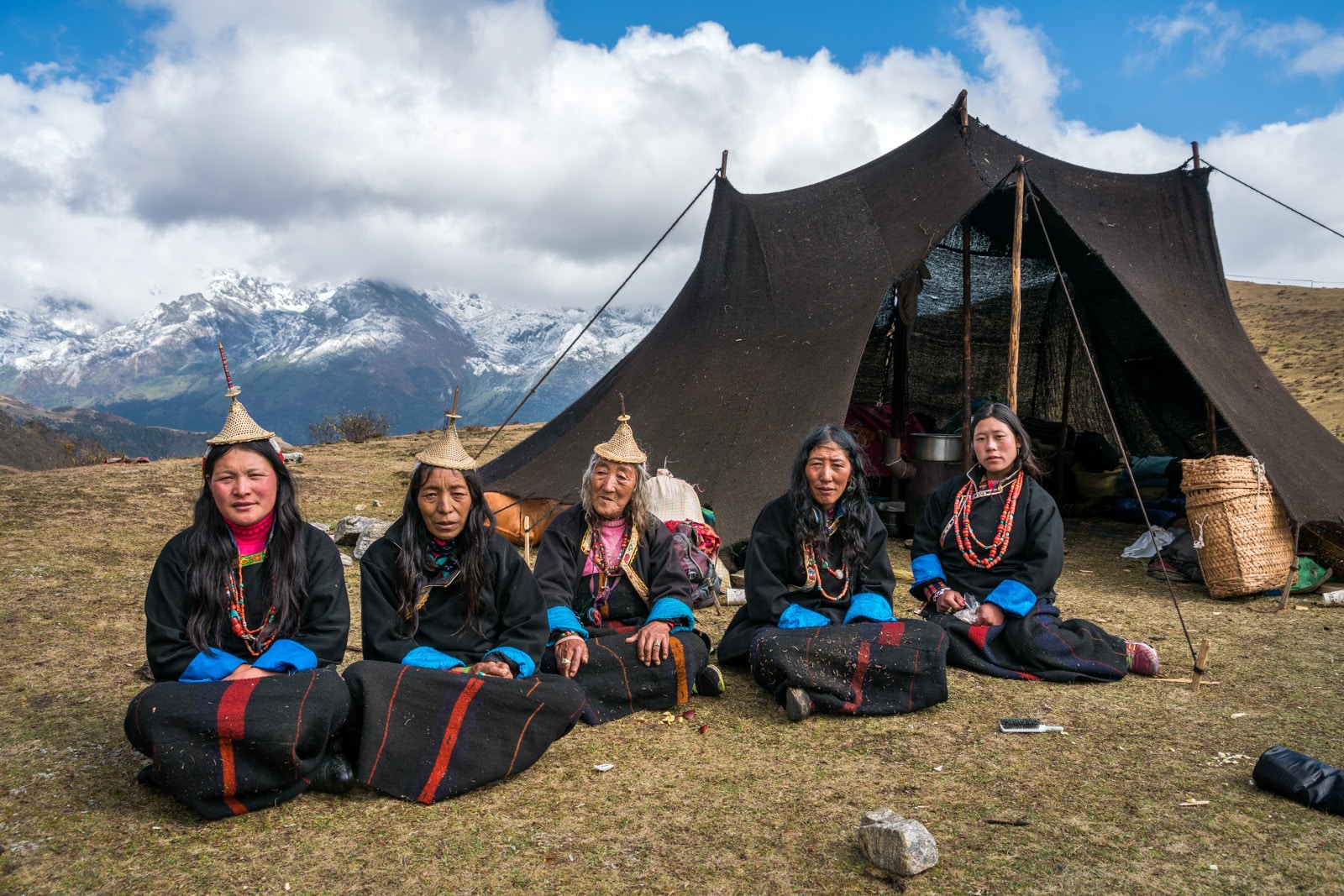
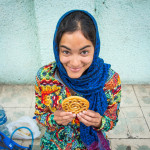

Wow, Awesome pictures! definitely convinced me to go and visit this beautiful place!
Thanks a lot. Highly recommend it!
Amazing experience and photos! I would love to travel to Bhutan some day. This festival seems to be perfect to get to know the culture. I would love it!
I have traveled to higher altitude in the past, but this was in South America and I there drank a lot of coca tea to adjust. Did you had something like this too? Or just drink enough and safe energy when you can?
Just wondering; Did Gray Langur tours contacted you or did you contacted them to do this sponsored tour? 🙂
I’m looking forward to read more about Bhutan!
Yeah Bhutan is definitely amazing. Would highly recommend it.
We had water and tea to keep us hydrated, and some people had medicine against altitude sickness.
We were contacted by them.
Oh, I’m so happy I found your blog. What gorgeous pictures and information. I’m currently in Europe through the start of June but am planning on heading to Asia after that, and Bhutan (via Nepal) is at the top of the top of my list. I won’t be there for this festival (sadly will be resuming my regular existence by October) but I can’t wait to read up on your insight.
That’s great to hear. We’re sure you’ll have an epic journey. Enjoy!
Hi Alex and Sebastiaan!
Asa, Alicia and myself appreciated your company and contributions while on the tour very much, and this article with the incredible photography and descriptions bring me right back to Bhutan.
This article is very good.
You are both such kind, good-natured travelers and I’m so grateful to have made the trip with you both.
Keep doin’ what you’re doin’.
Maybe see you in the future.
Later guys!
Aaron Cubbage
Thank you fot amazing picturs withits well describtion.
You’re most welcome!
My forehead (as Bhutanese) is twitching out of regret for letting slip two of Royal Highland Festivals. I’ll for sure attend 2018 RHF. You reminded me..:D
With some luck we will meet each other at the next RHF then 🙂
What an amazing read! The cows look particularly dolled up for the occasion! 😀
Yeah it was really cool. And they are yaks, not cows. Just as tasty though 🙂
What an awesome place, and your photos are so beautiful. You introduced me this country in best possible way!
Aw, thank you! Yes, the Royal Highlander Festival was seriously stunning, and a great display of the diversity of Bhutan.
Amazing photos of this Bhutanese festival, Alex! My eyes kept getting drawn to the mountain alps behind, mind-blowing views! It must have been quite the experience to be standing there and taking in all these sights and sounds in person. I cannot forget Bhutan too, can’t wait to go again to see other parts of it =D
Hey Alex! I loved your posts on Bhutan – so much so that it inspired me to go! Unfortunately, I only have about 10 days to spend there, and I’m deciding between a trip that is mostly trekking with one or two days of sightseeing in Paro & Thimphu, or a trip that’s no trekking beyond the walk to the TIger’s Nest, but would involve visiting festivals and more sightseeing.
I love trekking, but I’m torn as to which trip to do! Do you think the trekking in Bhutan is spectacular enough to devote the majority of the trip to? Or is it better to see more of Bhutan’s culture and spend most of the time at festivals/visiting the cities (so more interactions with locals and seeing daily life)? Thanks so much for any input you could give!
Hey Carolyn! It’s awesome to hear that I’ve inspired you to head to Bhutan, you’ve made my day 🙂
Personally, I feel Bhutan’s cultures and the way they’re preserved are some of the main selling points of the country. I’d head to Bhutan for culture over nature, as it’s truly unique and the way it’s managed is quite inspiring.
However, that doesn’t mean you have to cut nature out of your itinerary entirely! Bhutan is ridiculously beautiful and the perfect playground for trekkers. If you’re looking for a trekking experience, I think you’ll be disappointed by the “trek” to the Tiger’s Nest—though pretty, it’s just a two hour walk uphill.
You could seek out opportunities to combine culture with nature—this Royal Highlander Festival is a perfect example—or divide your time between the two. Ask your tour operator about trekking between villages, or find a 3-5 day trek you can add to your cultural sightseeing program. A friend told me the lakes around Phajoding (between Thimphu and Paro) make for a really beautiful trekking destination. I believe the trek to them is part of the greater Druk Path between Thimphu and Paro, which can be divided into a variety of shorter segments that would fit your schedule.
Hope that helps!